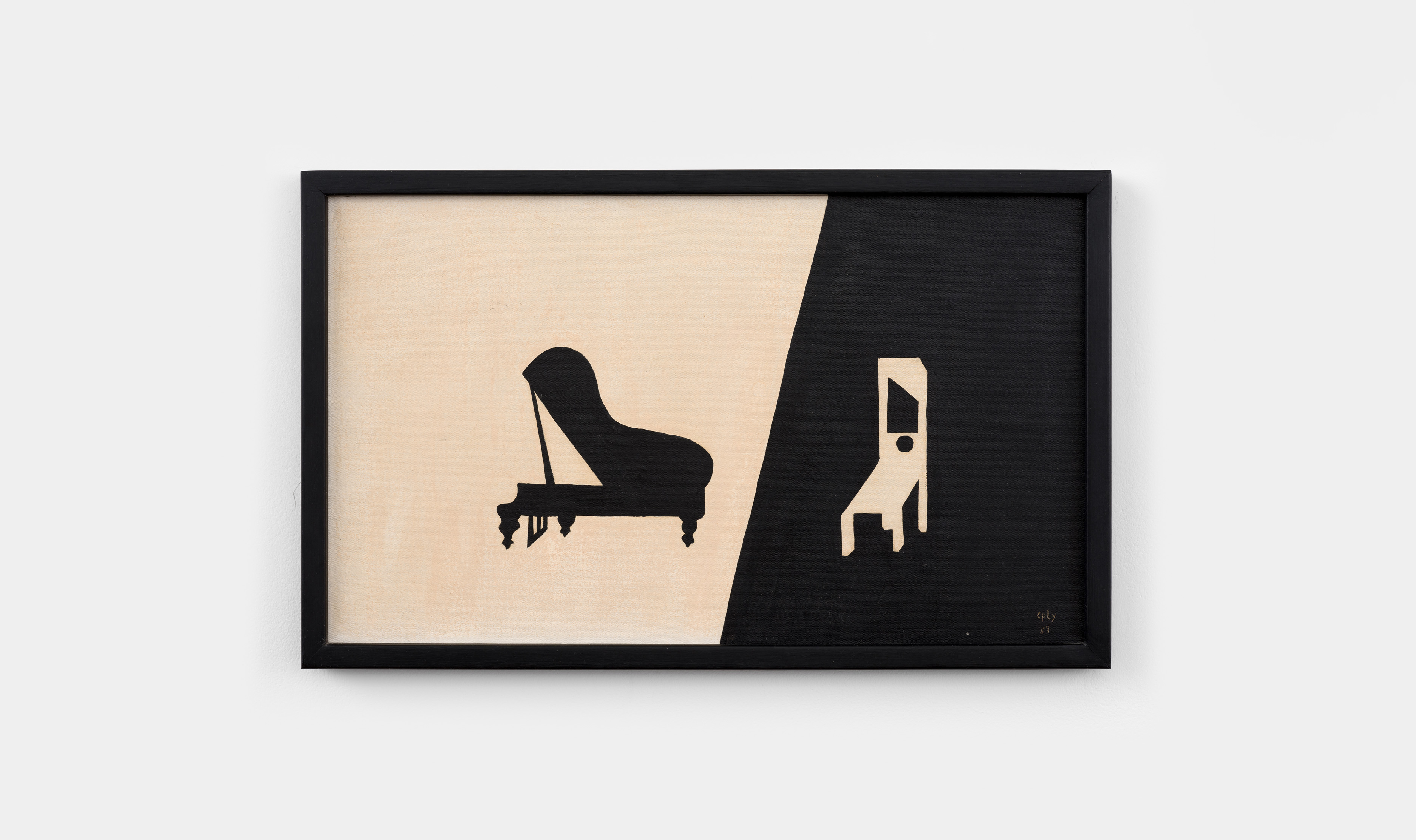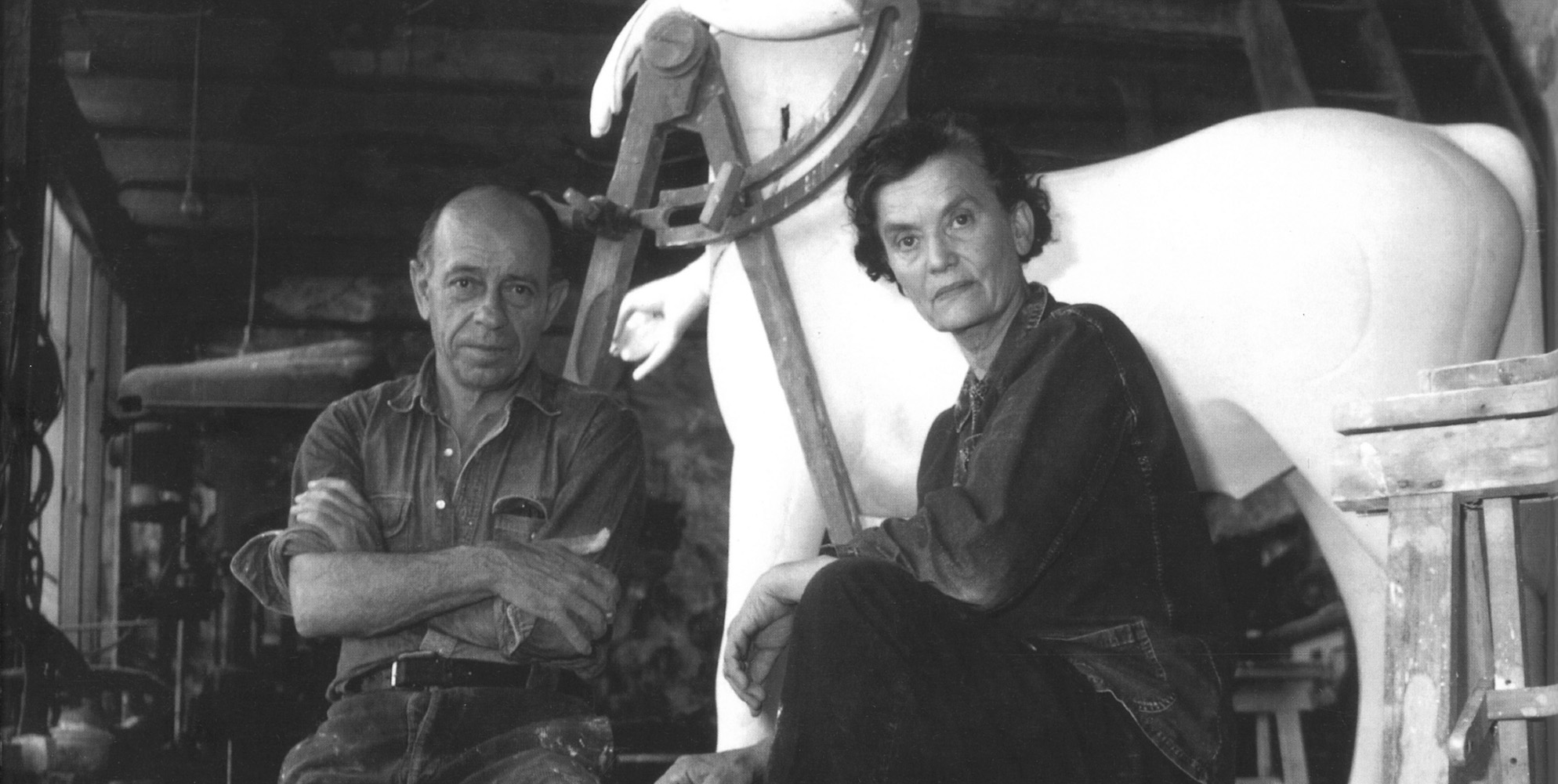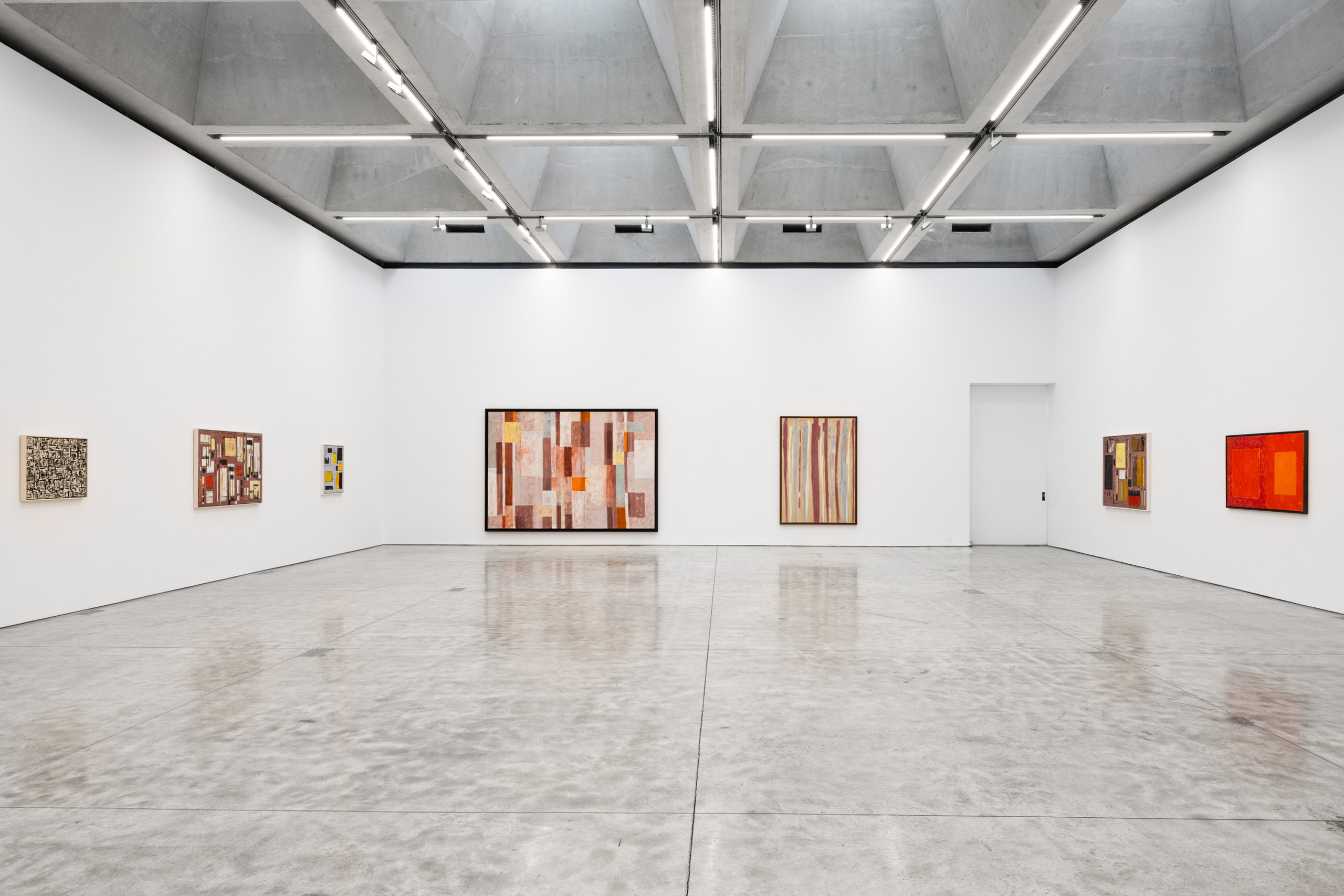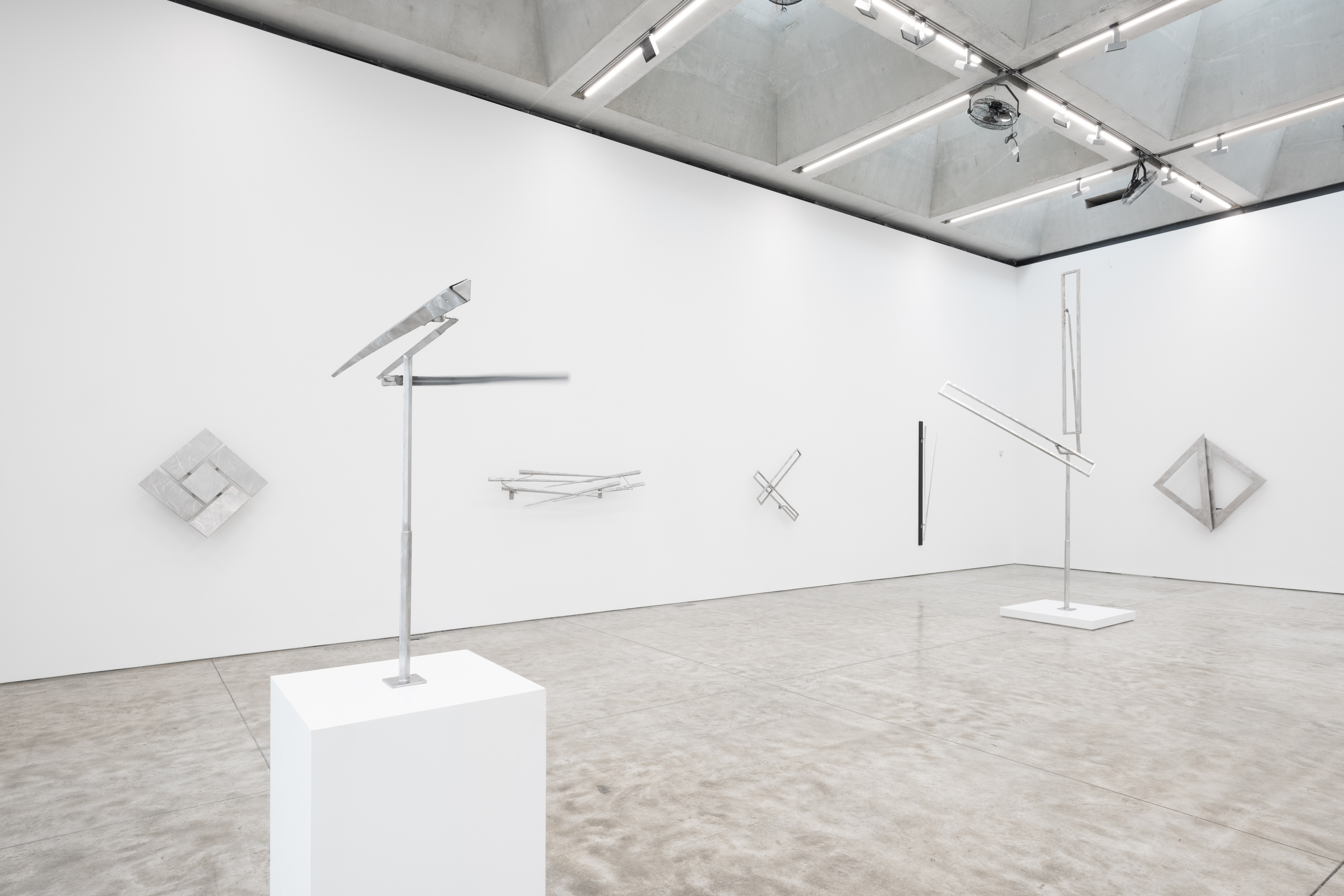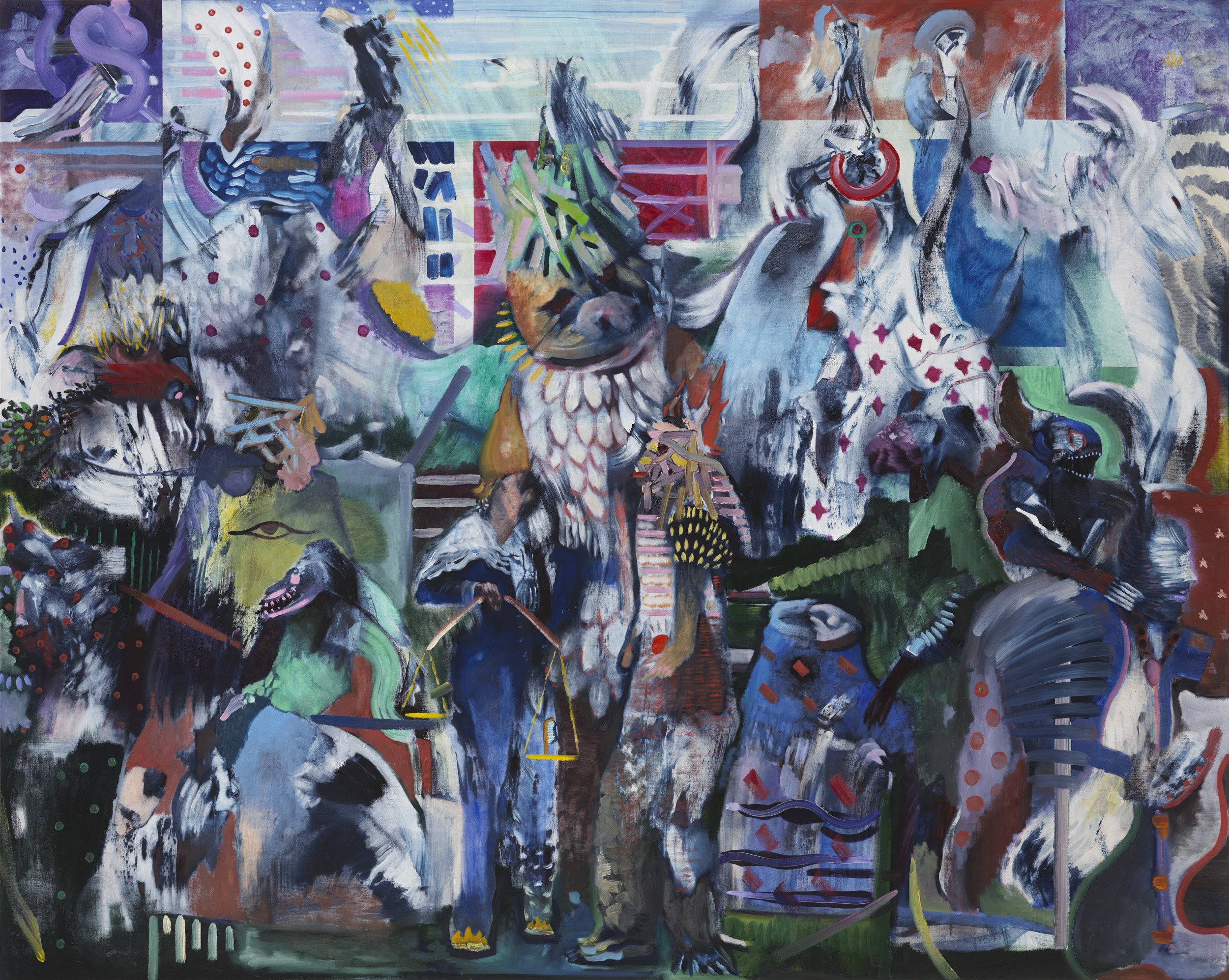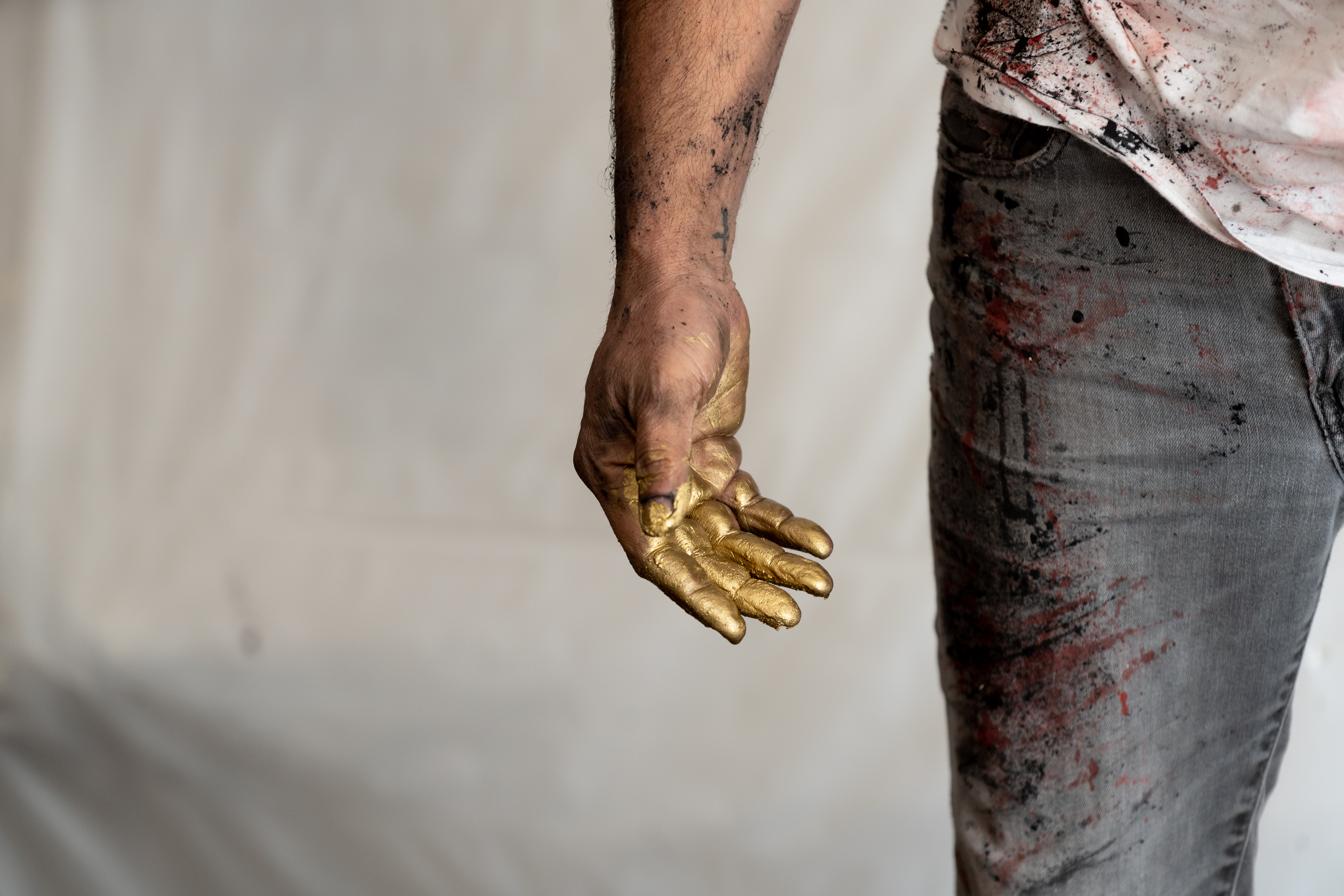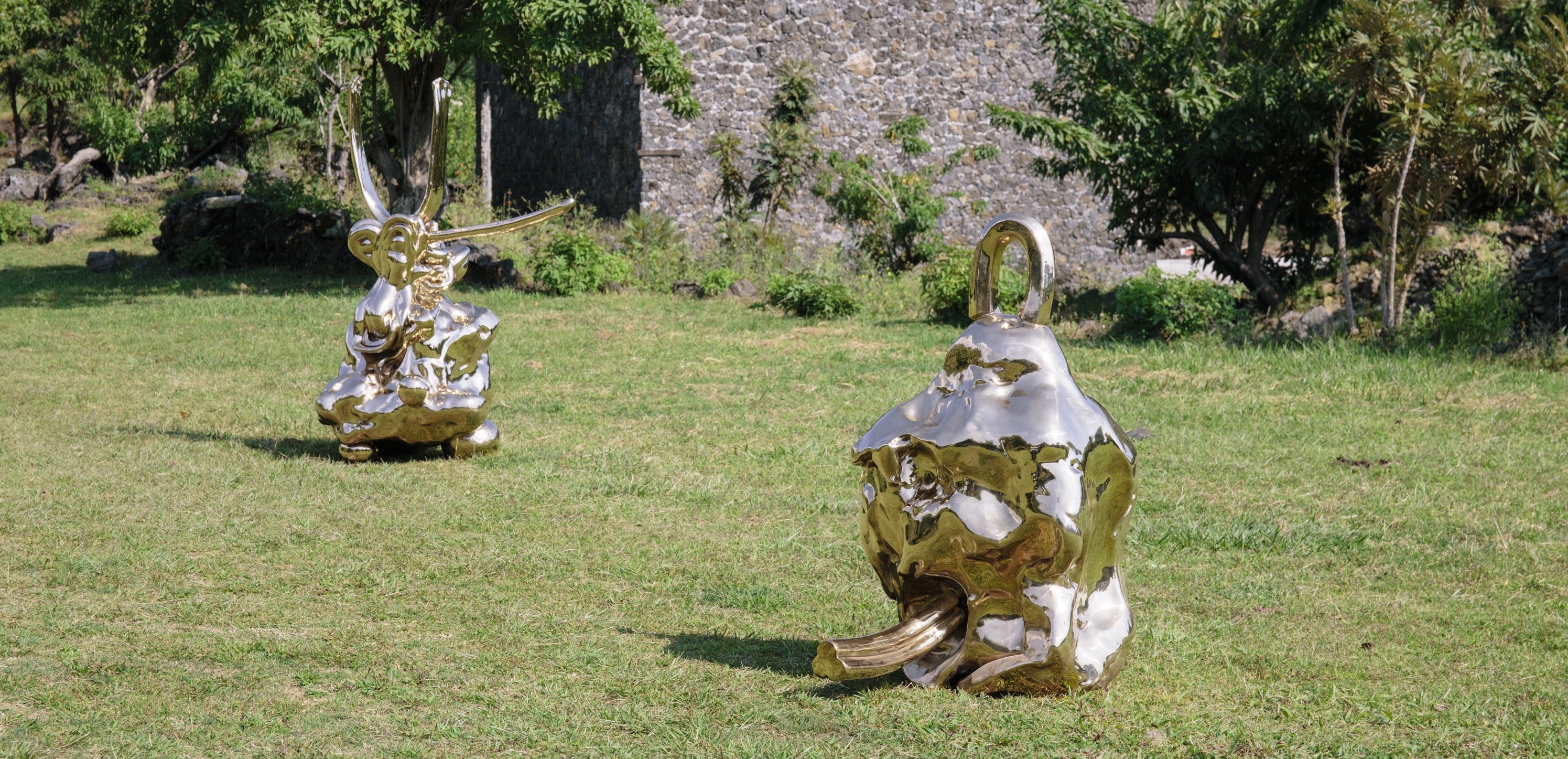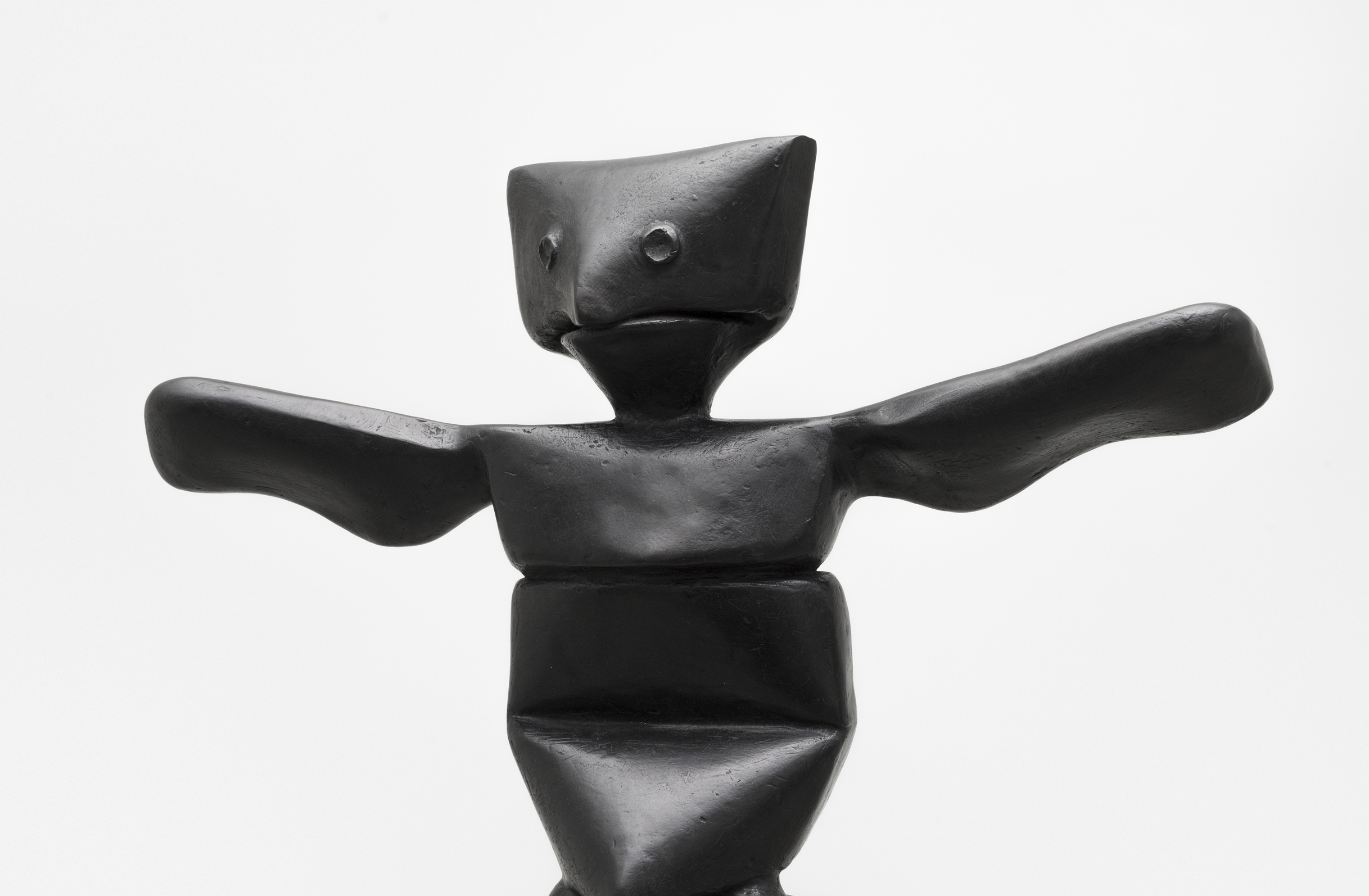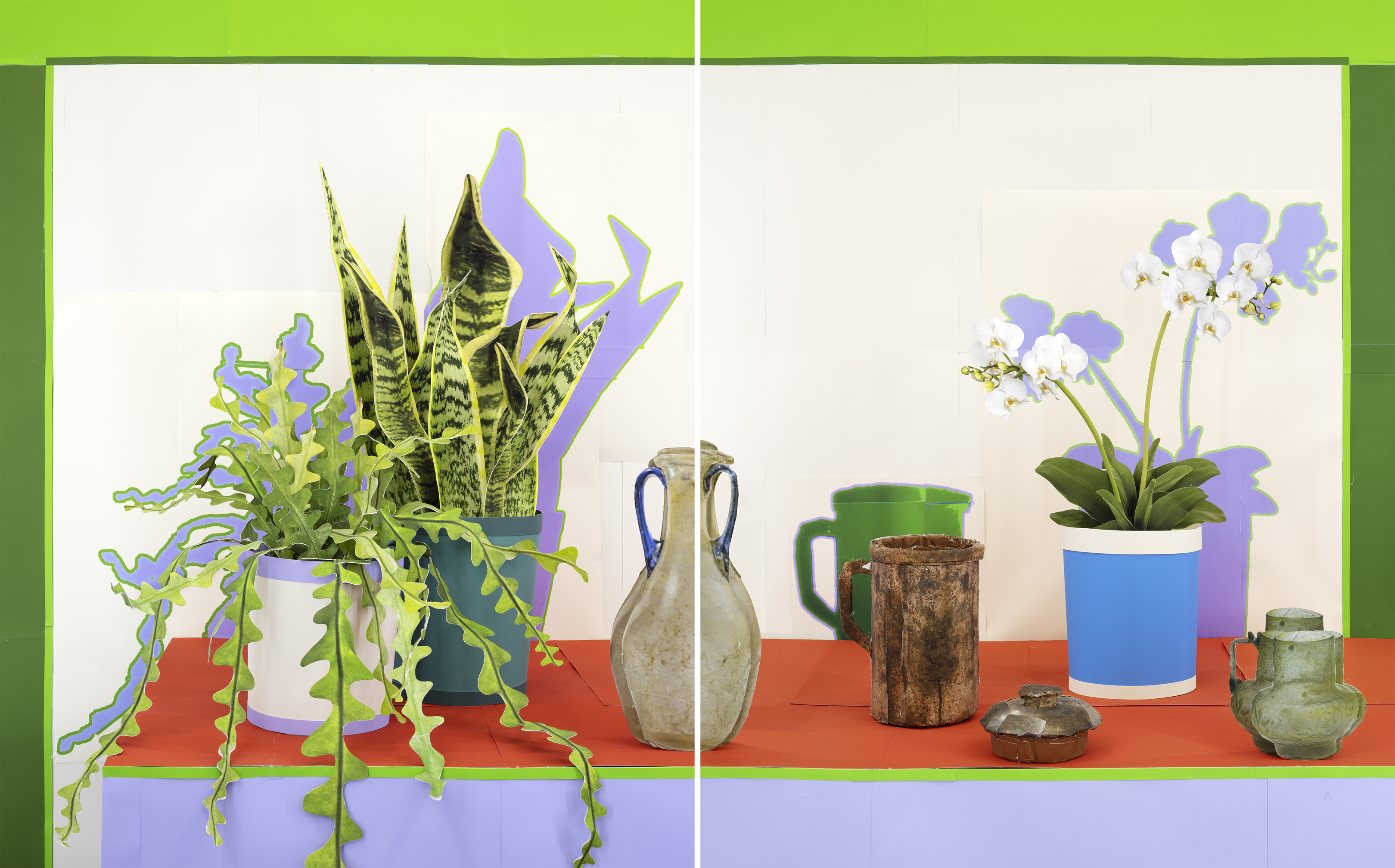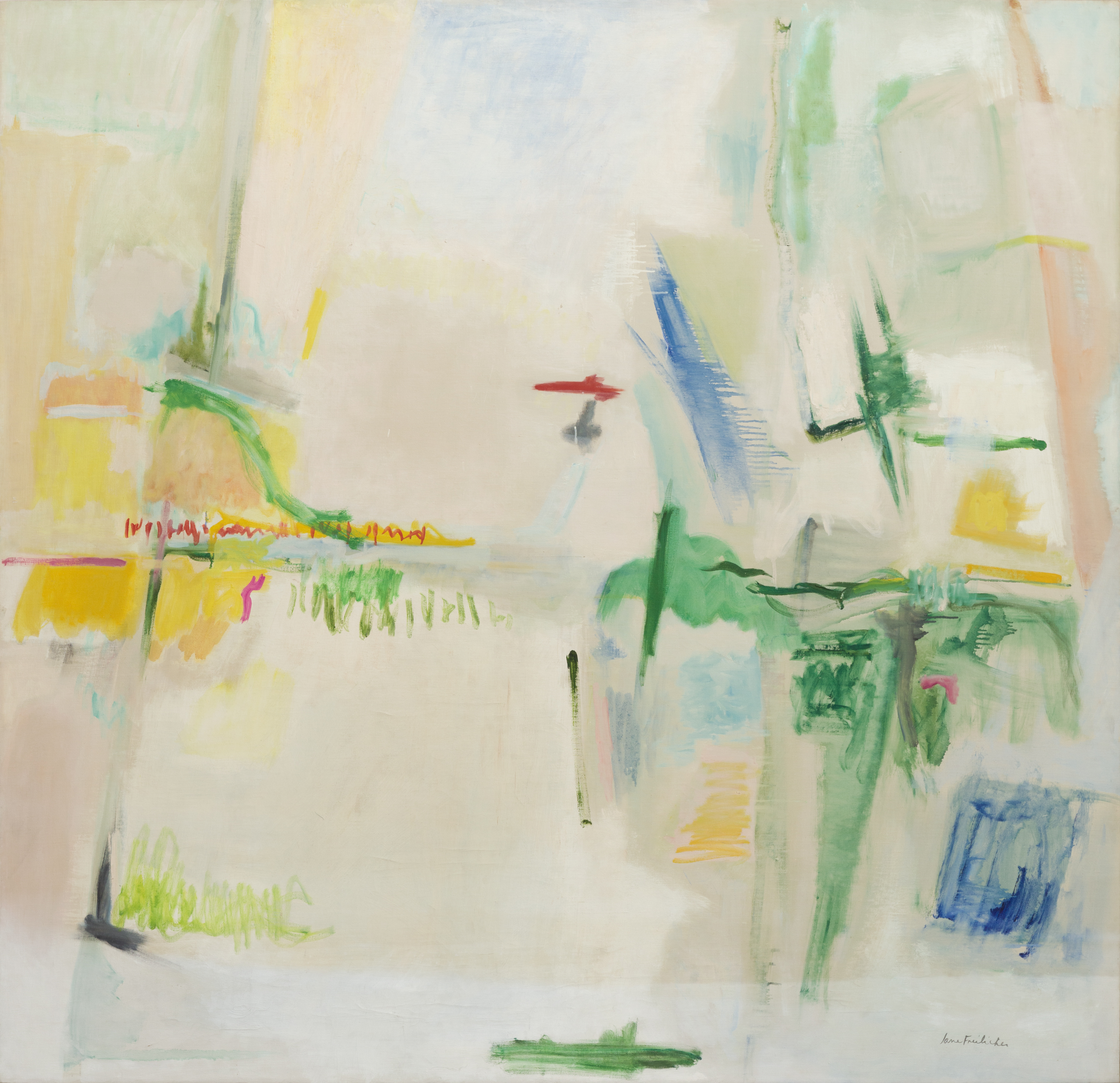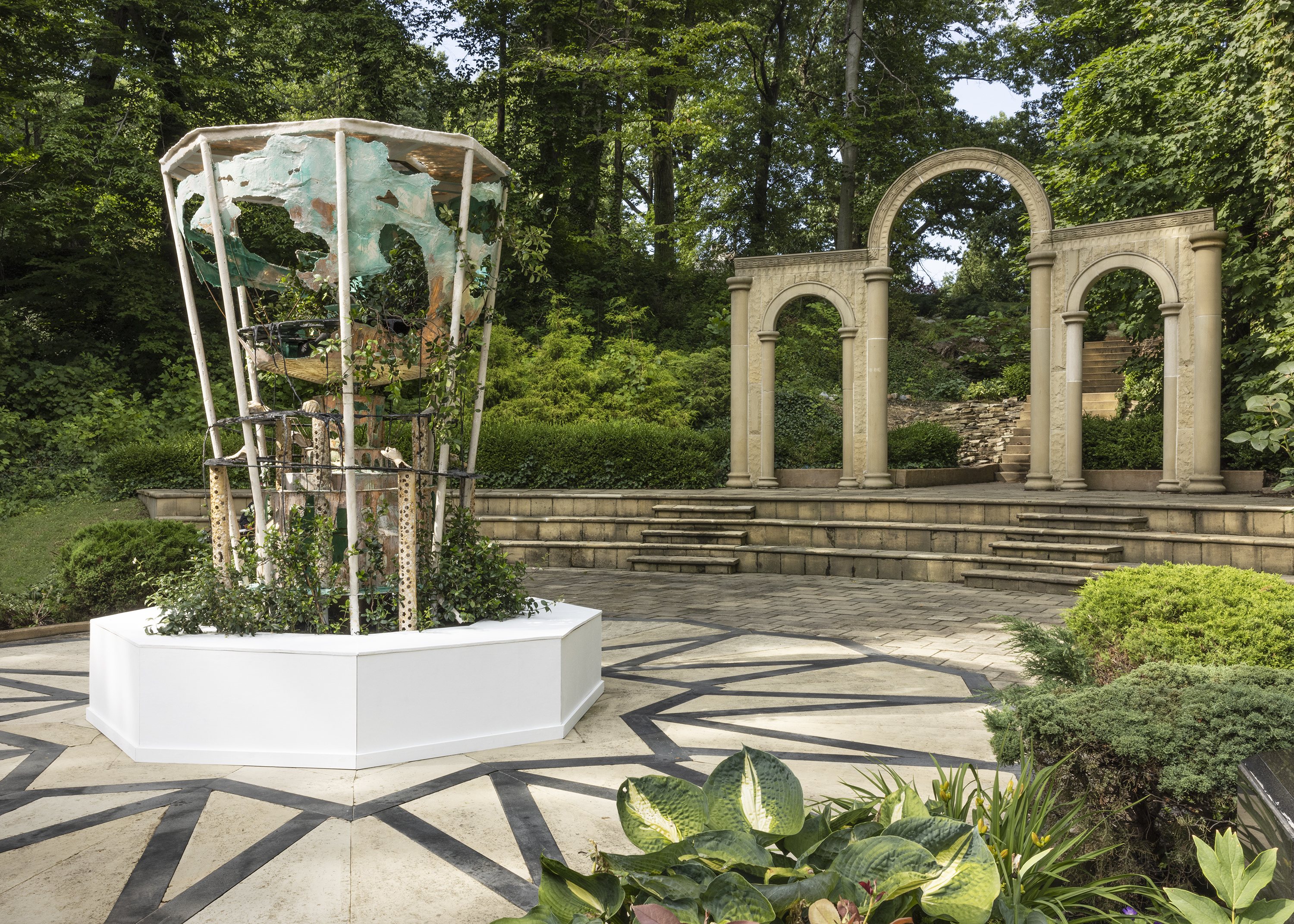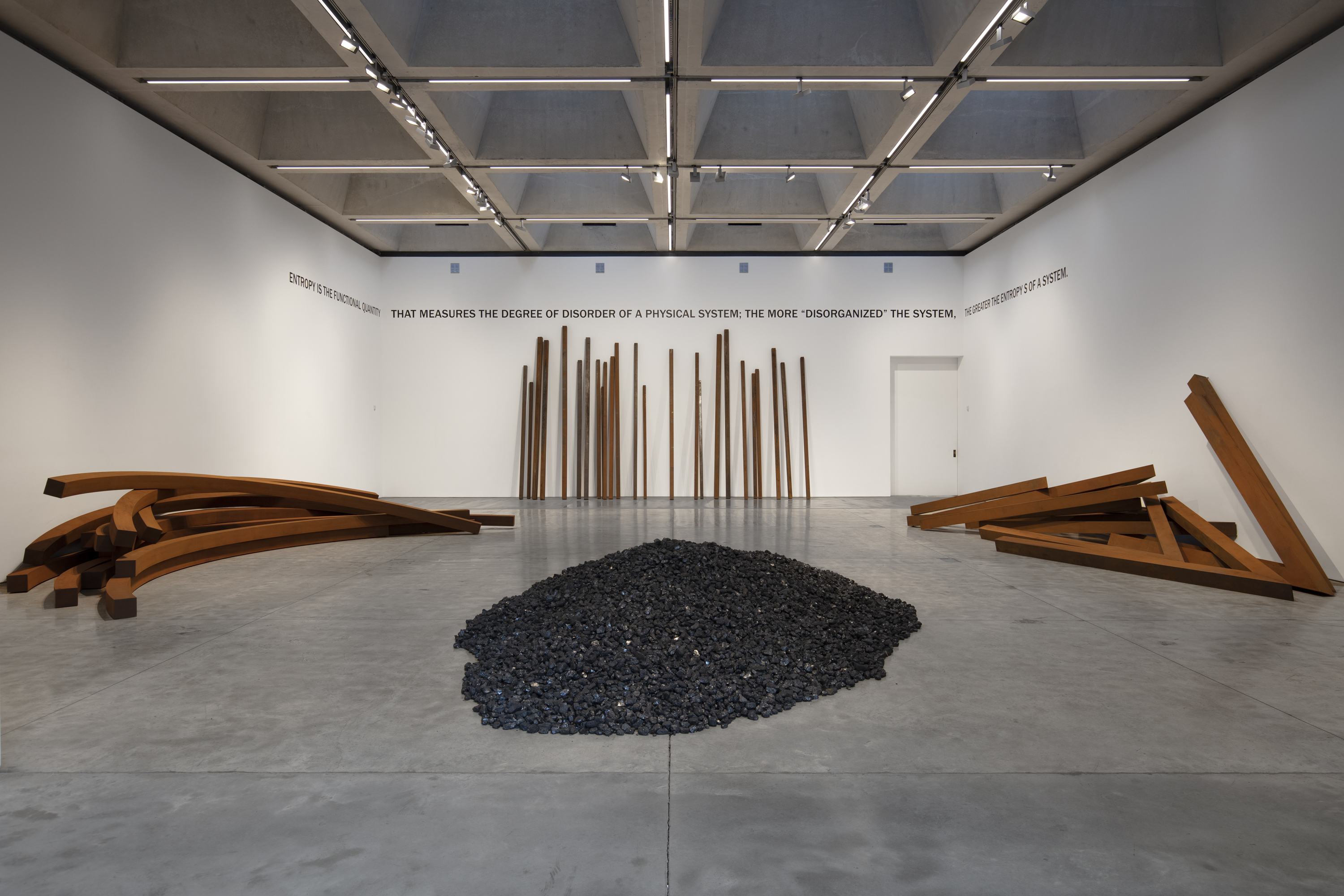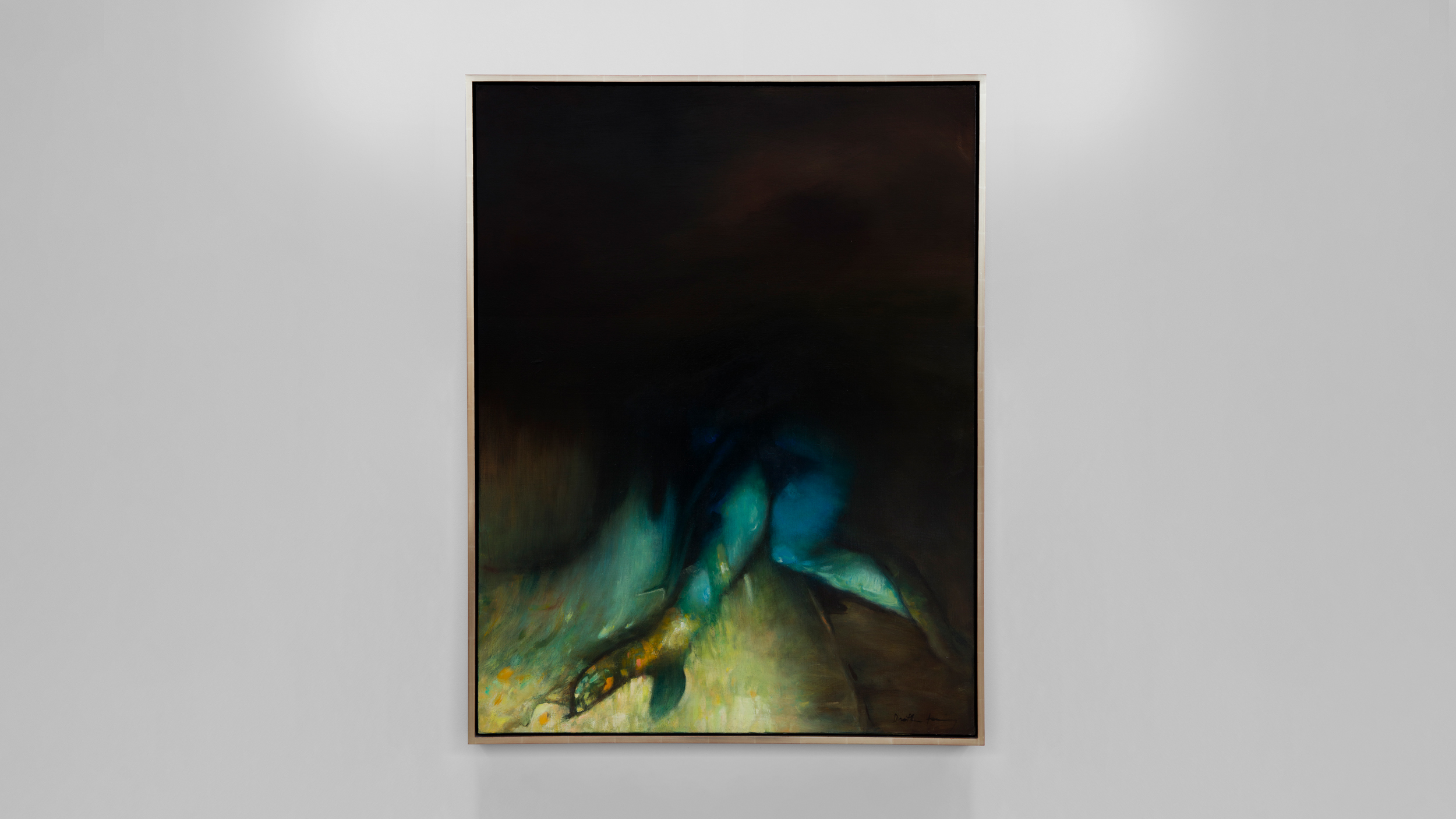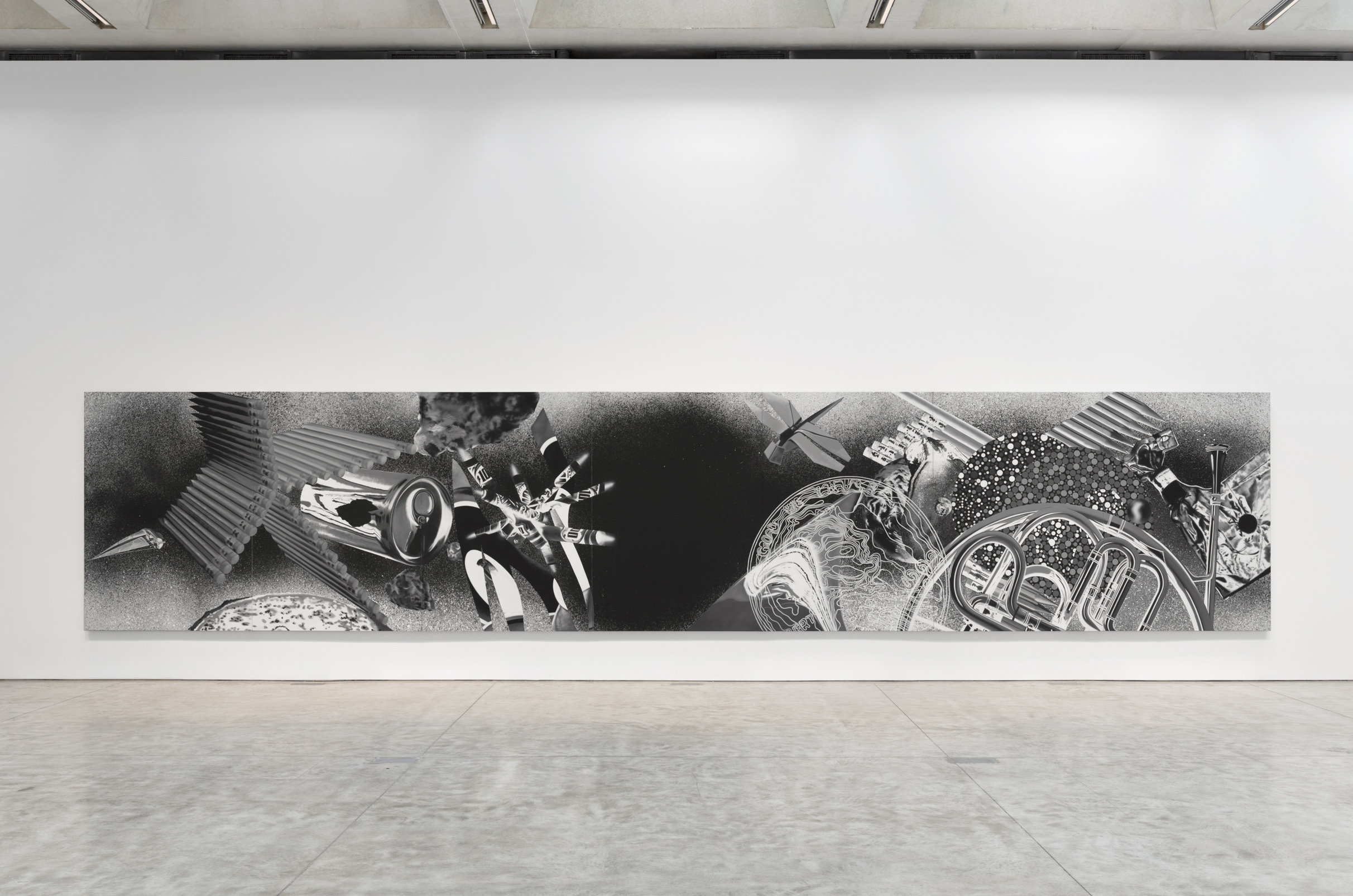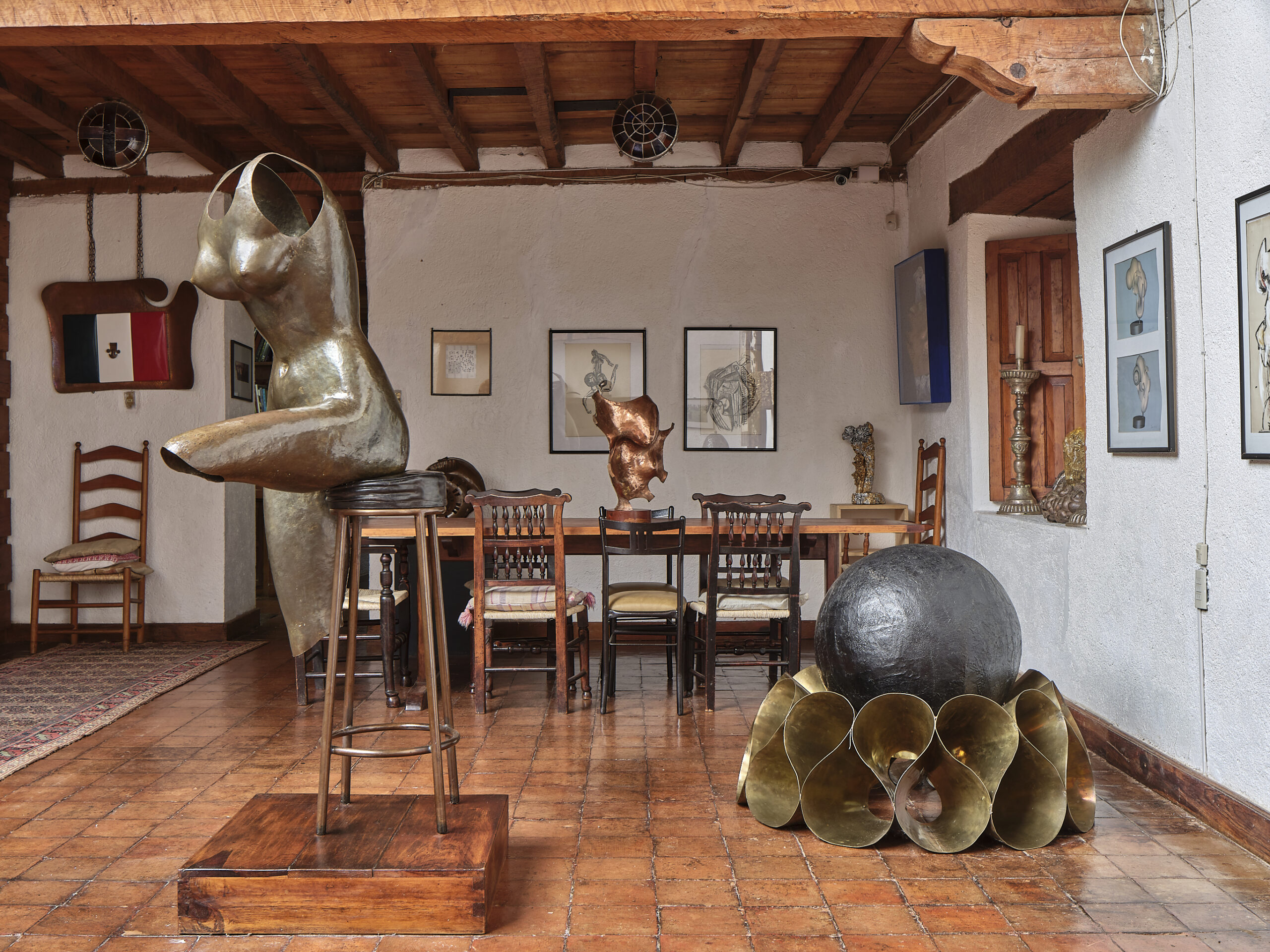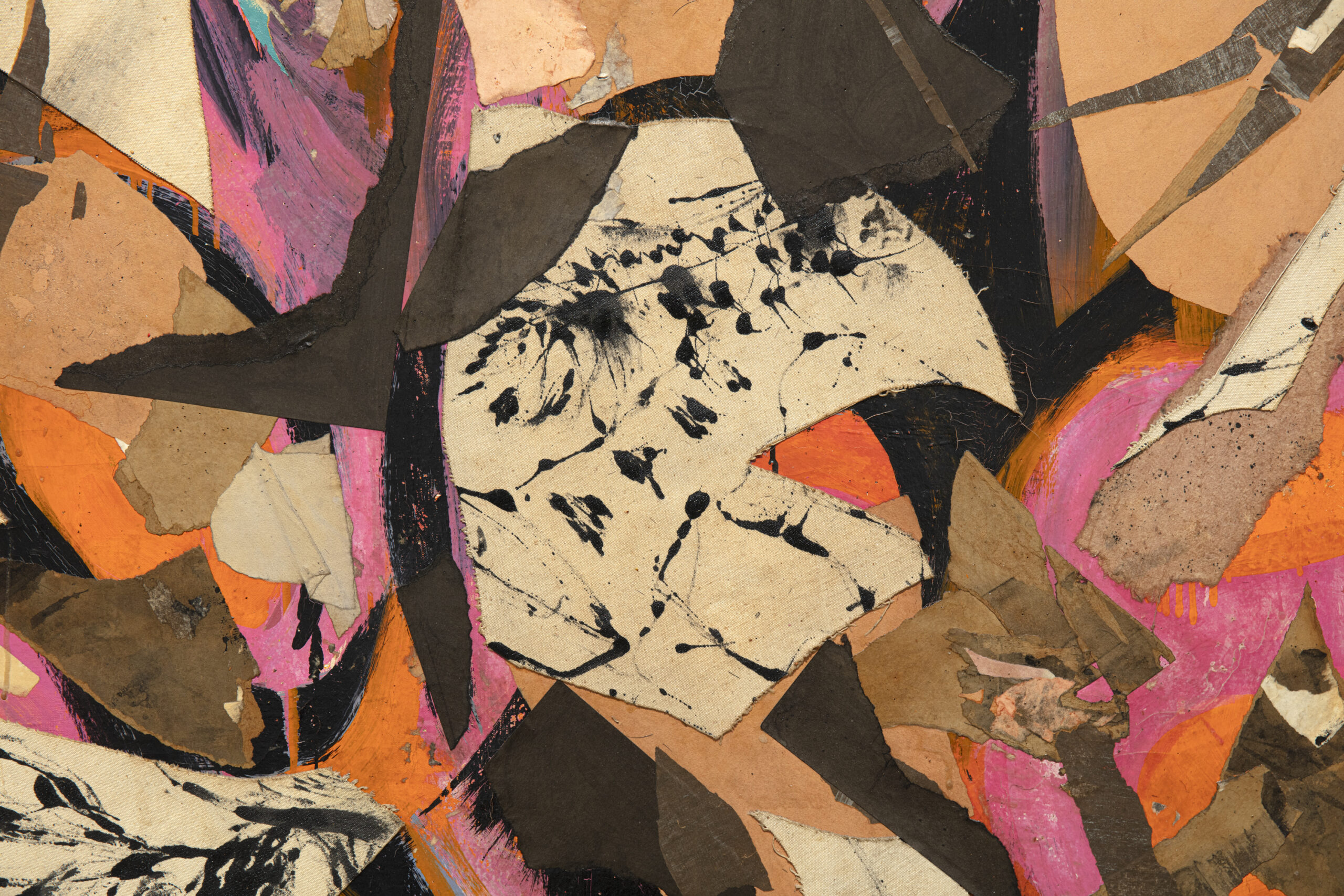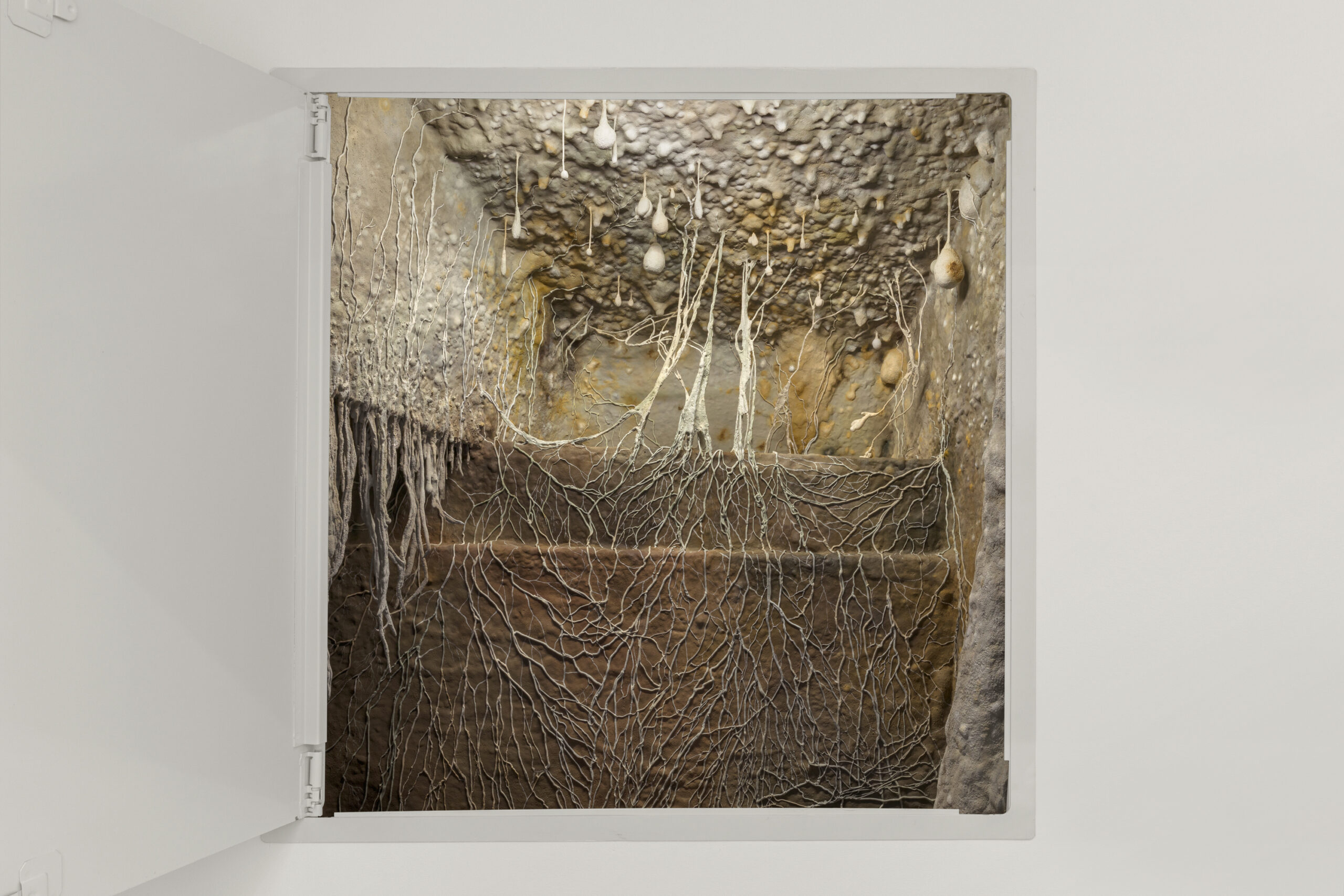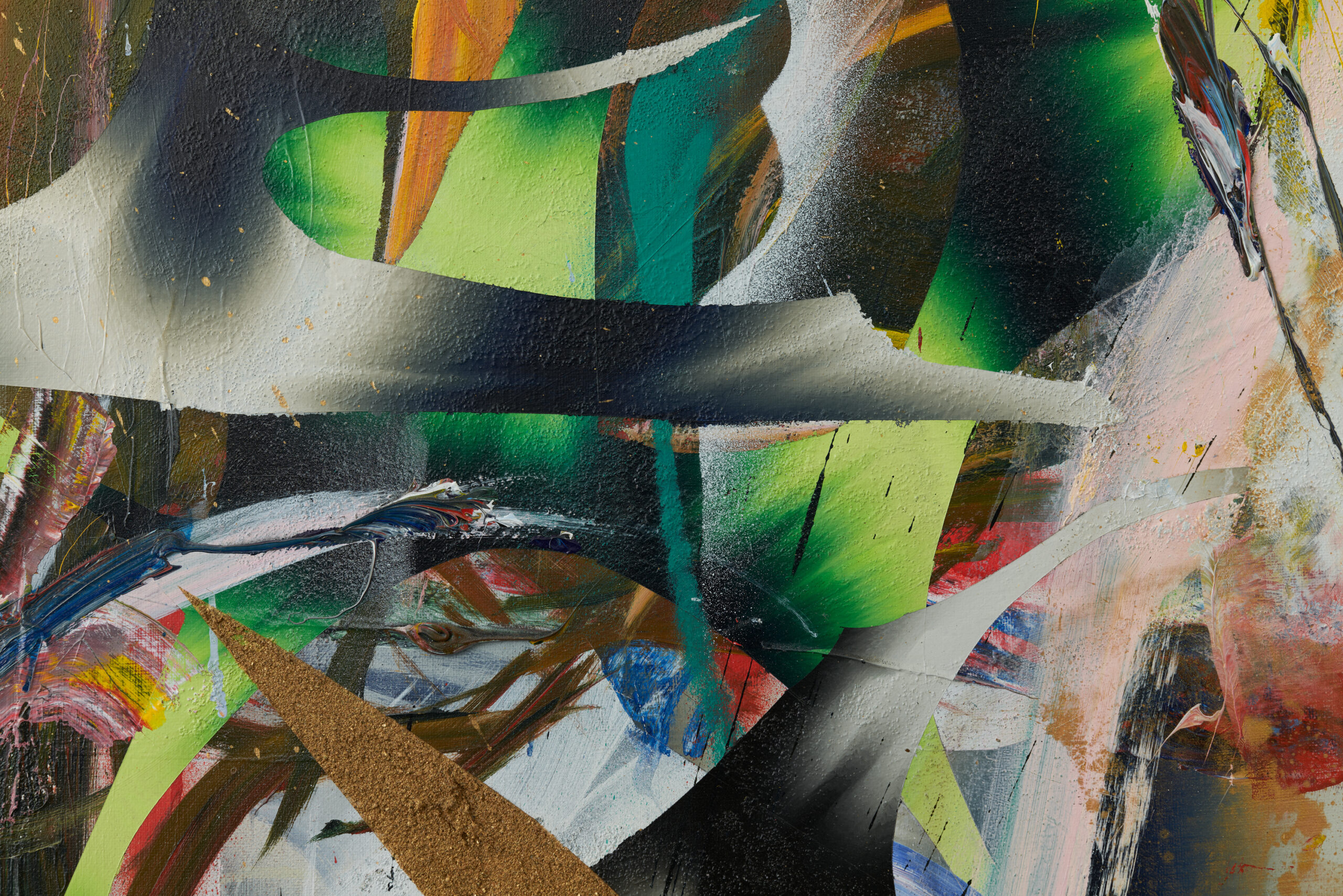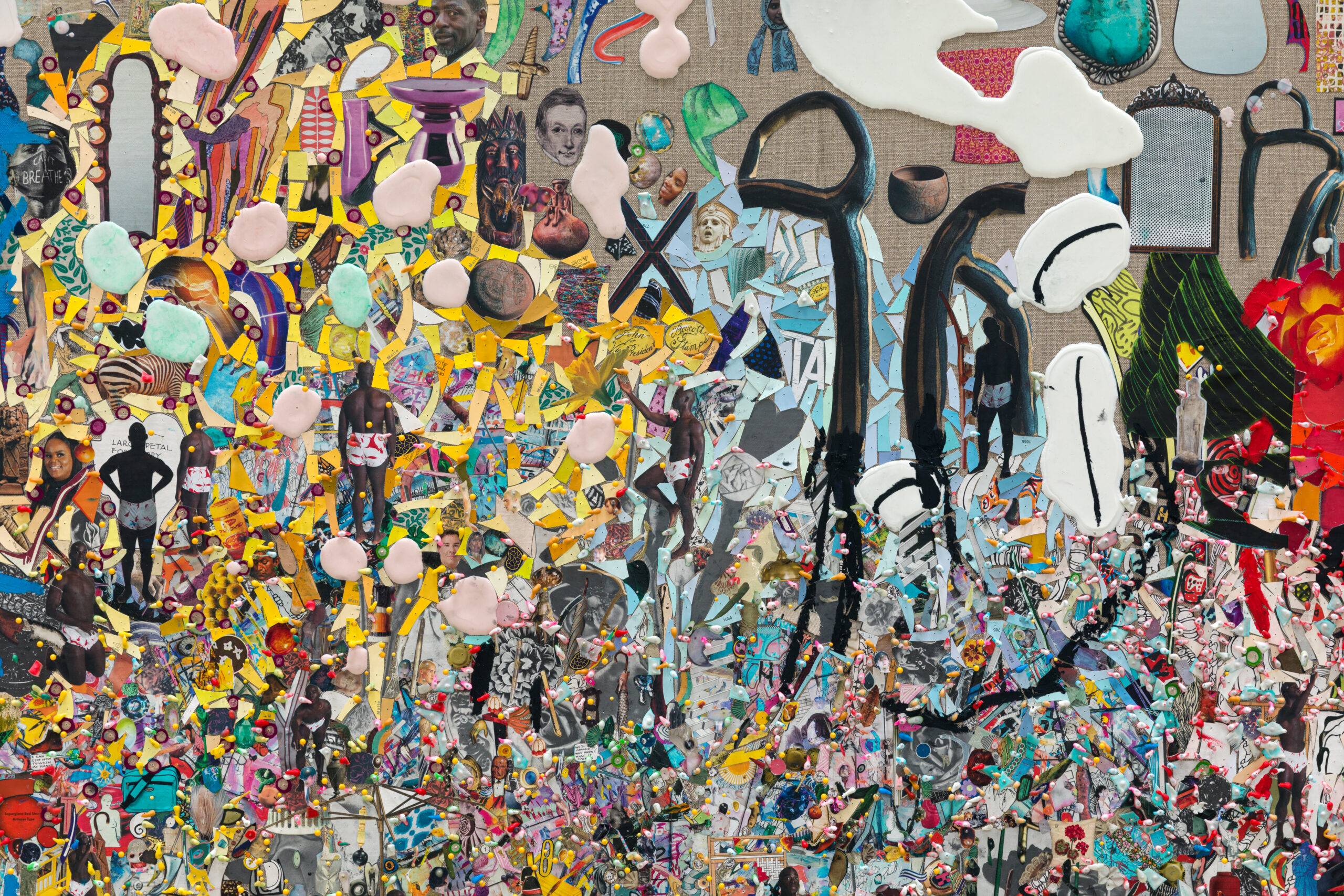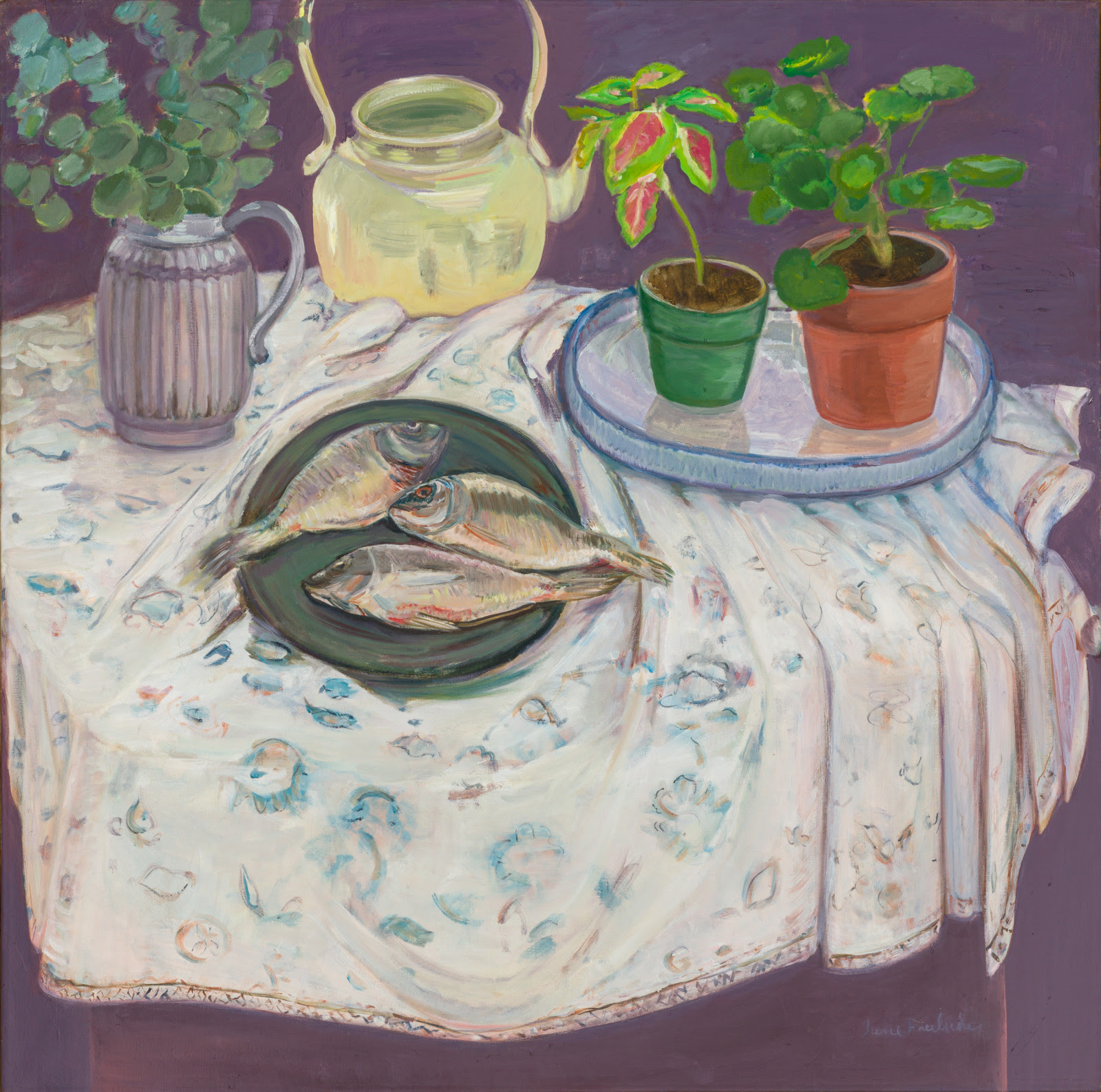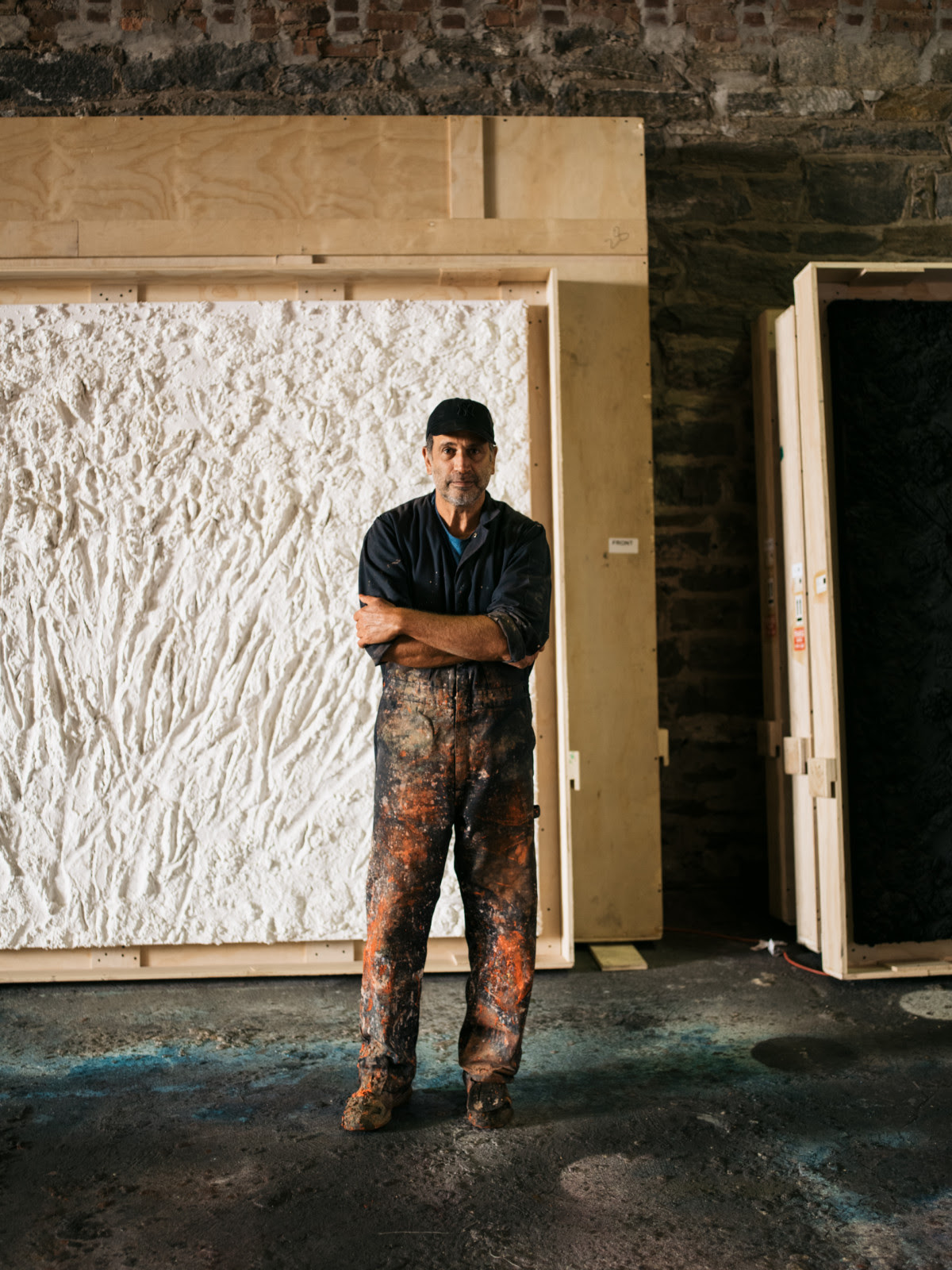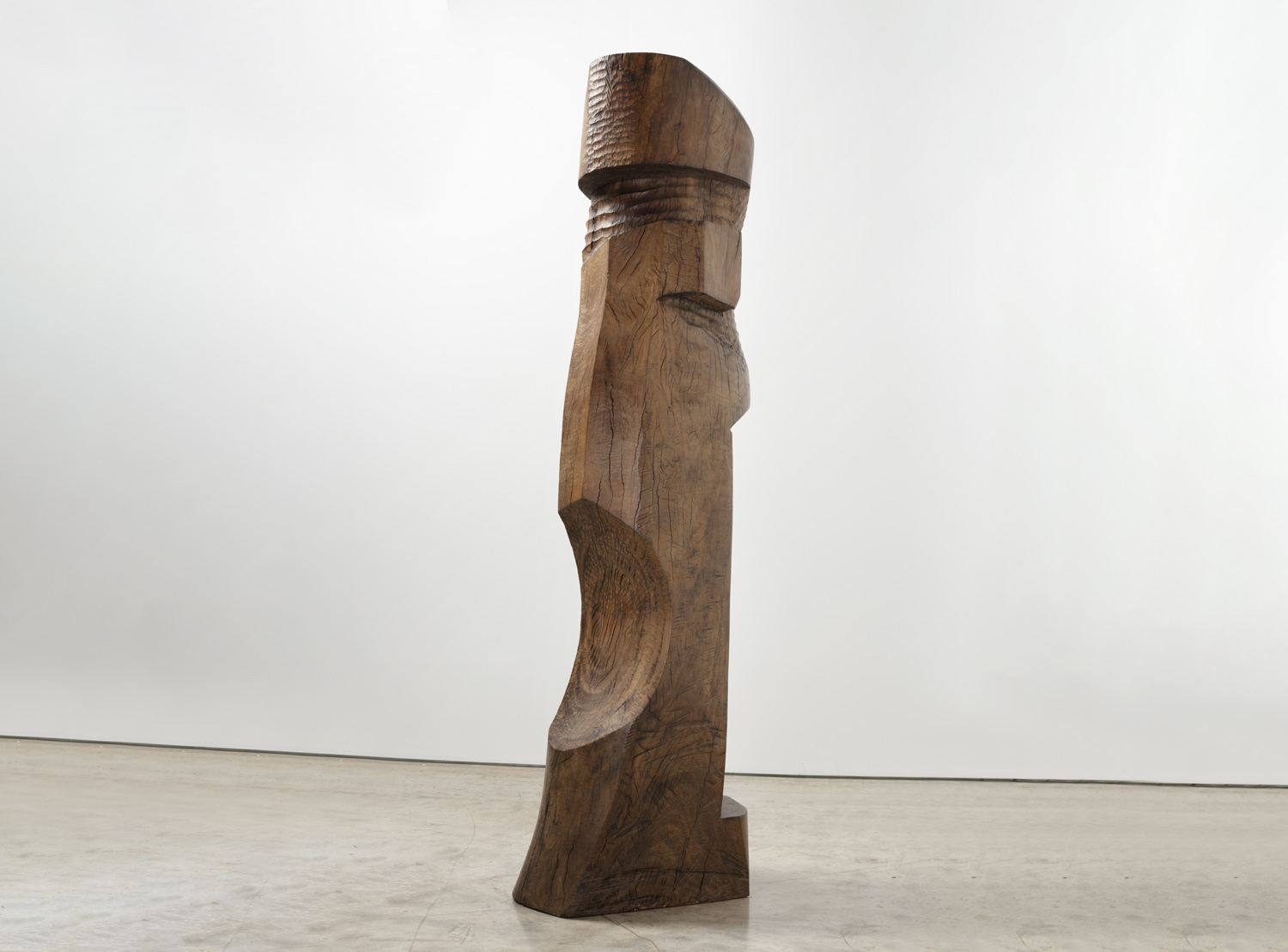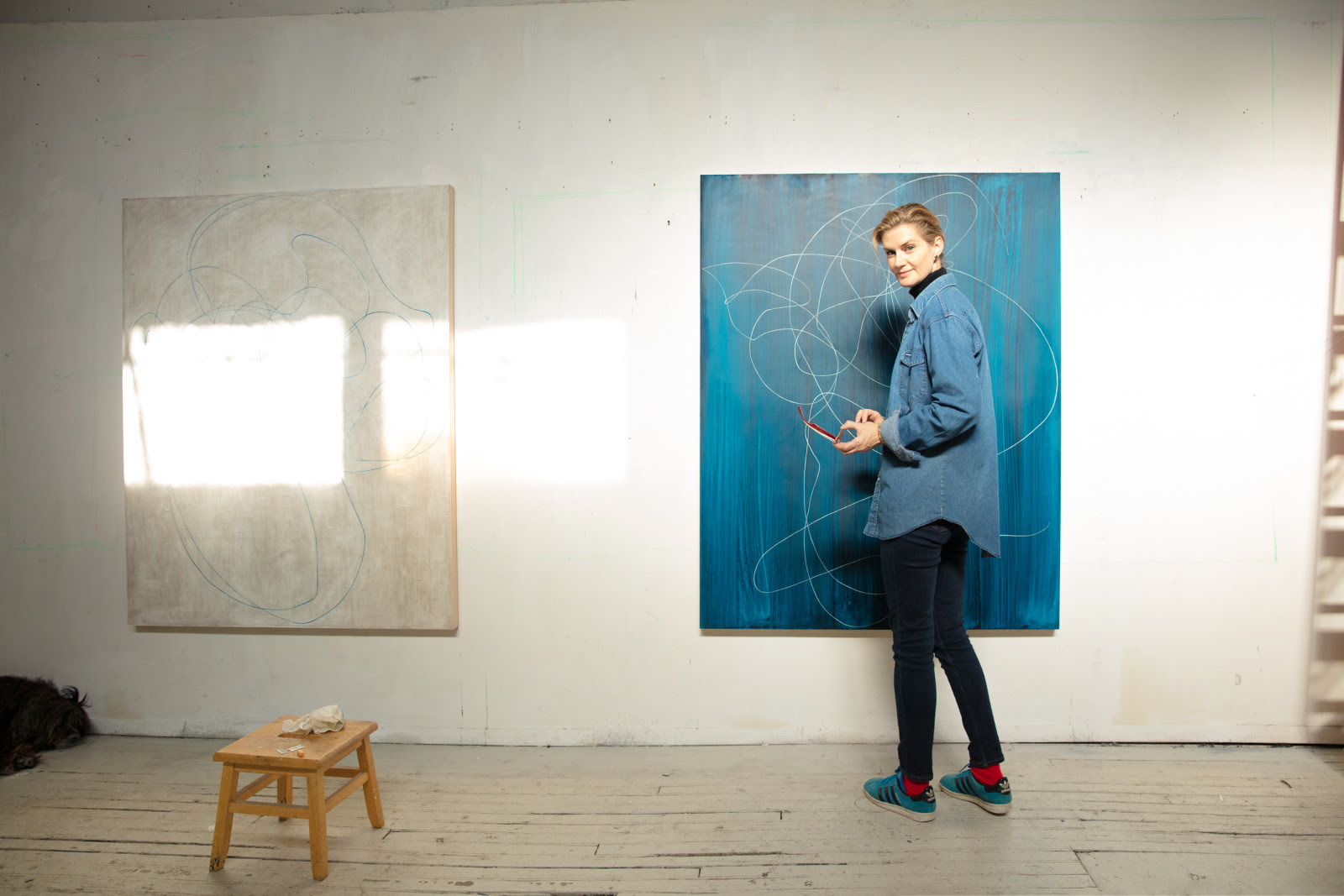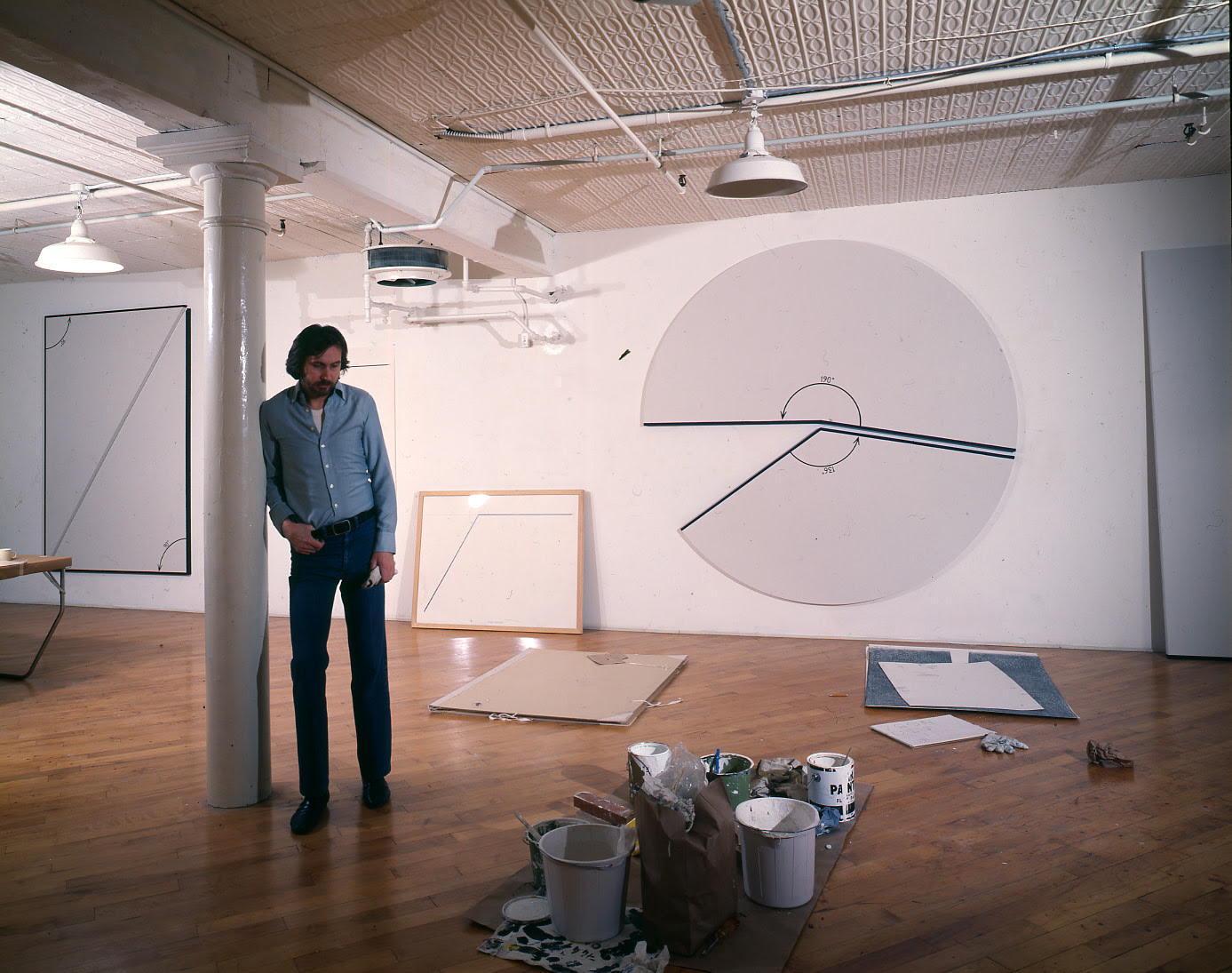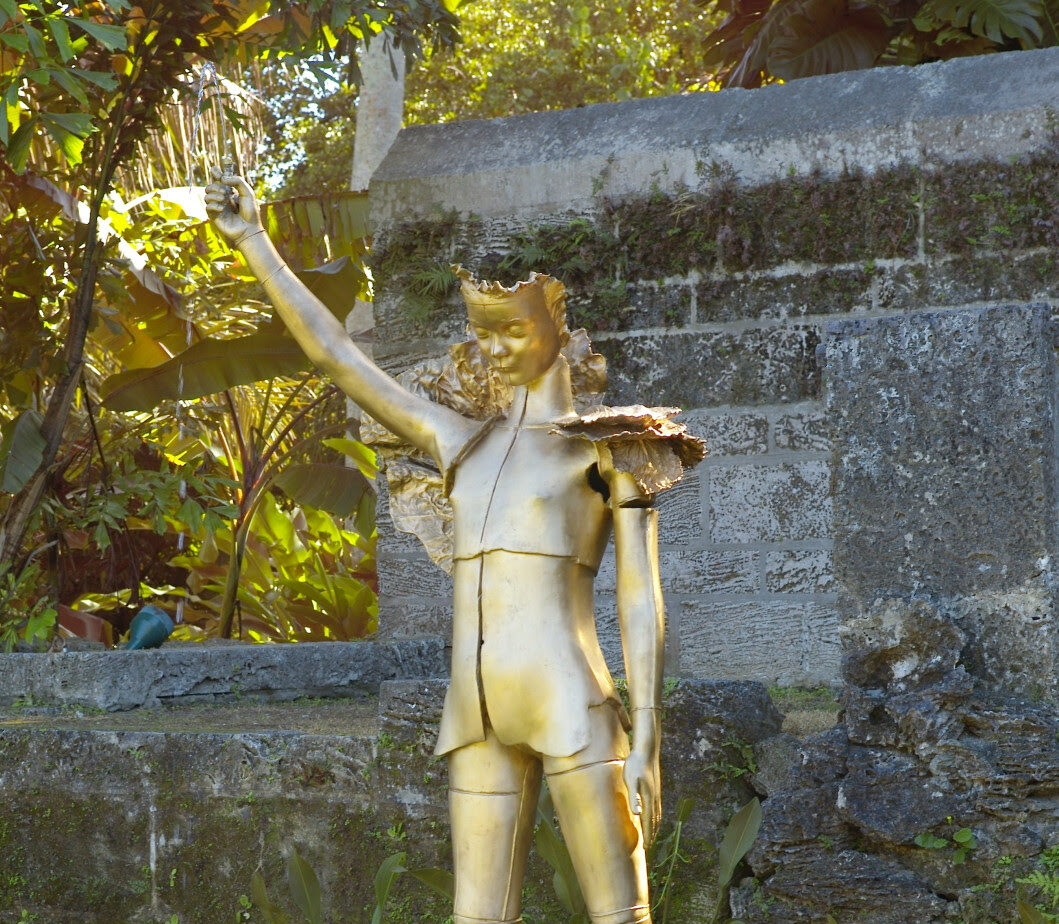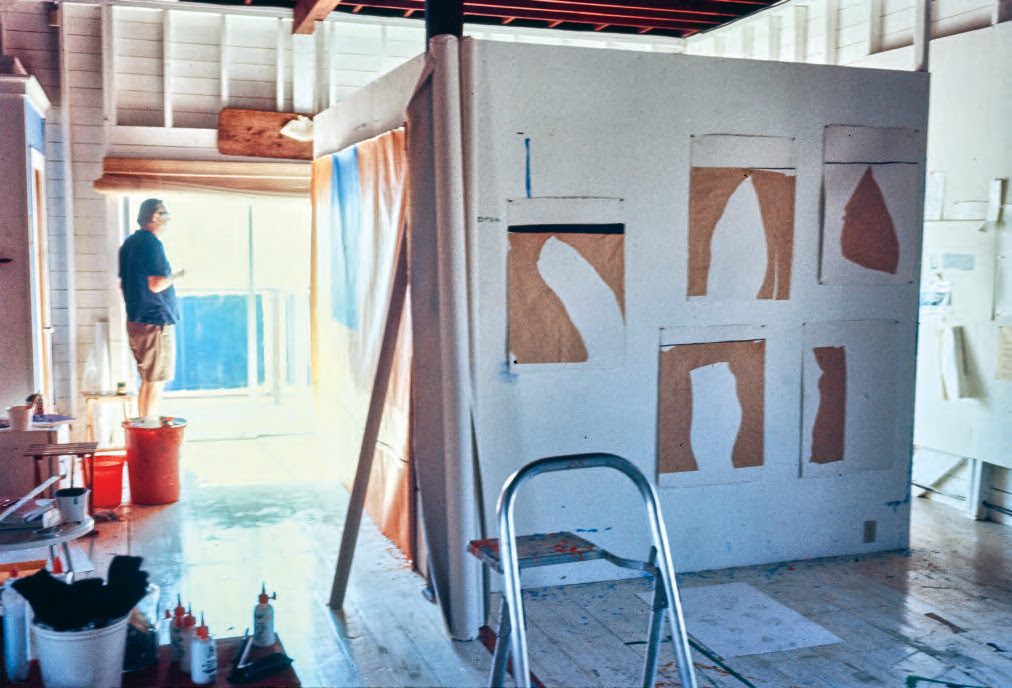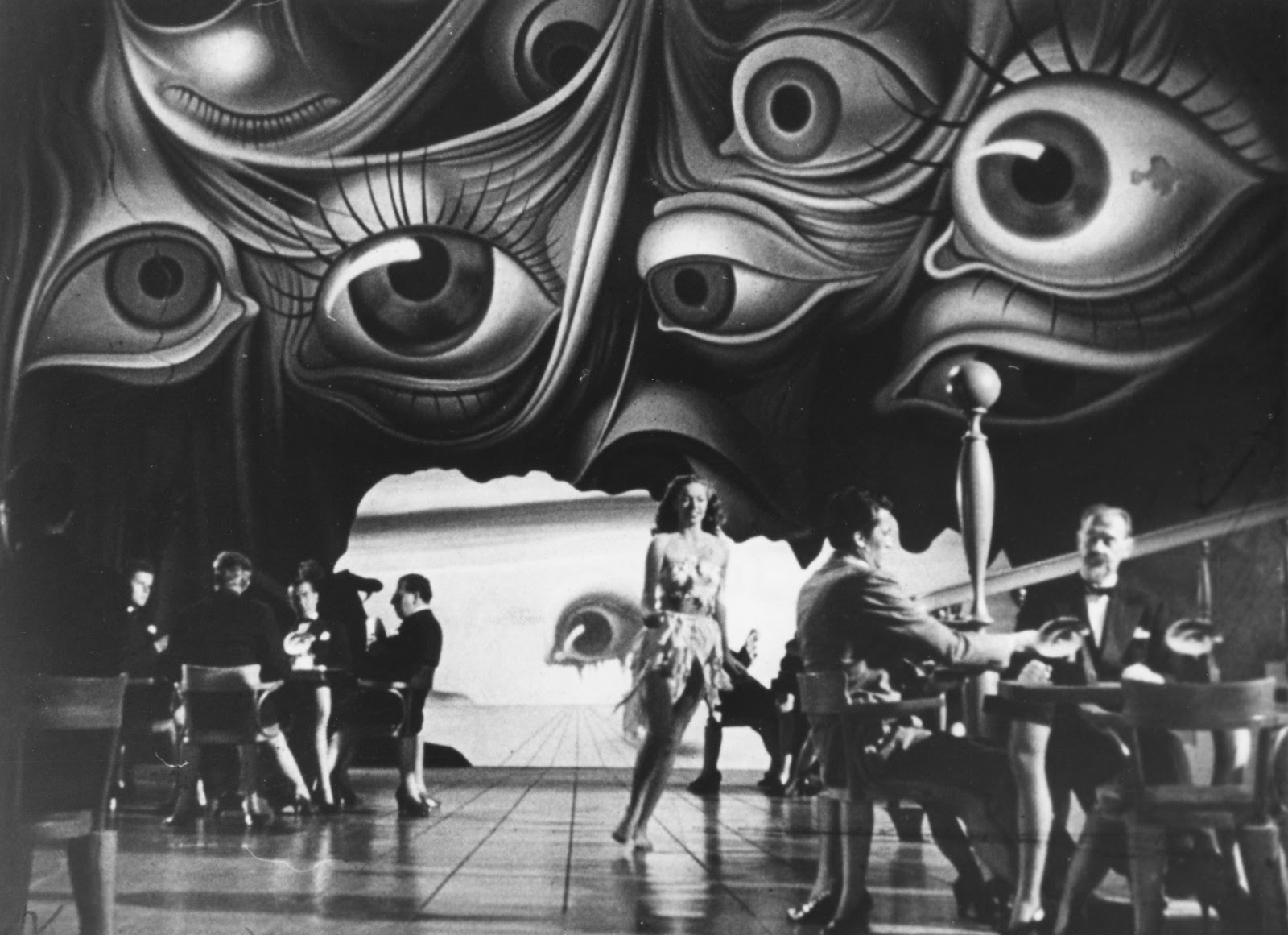On the occasion of William N. Copley: LXCN CPLY, curator Toby Kamps explores the artist’s development of his signature visual language, illustrating how Copley’s practice included a distinct alphabet of images to which he repeatedly returned, even as he explored diverse subject matter and source material. The exhibition LXCN CPLY is co-organized with the William N. Copley Estate, and is on view through May 11, 2024, at 297 Tenth Avenue.
Much has been written about the legendary life of painter William N. Copley, the artist known for his color, humor, and sex-saturated figurative imagery who signed his works CPLY. He was orphaned after his birth in New York in 1919 but came into great wealth when he was adopted by the family of a newspaper and utilities mogul. He opened the West Coast’s first gallery specializing in Surrealism in Beverly Hills in 1948 and through it became a friend and major collector of the movement’s leading lights. He honed his craft in France from 1951–1962, becoming a bridge figure, as his friend the curator Walter Hopps stated, between European Surrealism and American Pop. In 1962, Copley returned to the United States. Launching innovative publishing and patronage projects on the side, he worked almost full time in the studio until his death in 1996.
Less has been said about his distinctive vocabulary of motifs and styles, and his unique, totalizing vision of art and life. Summarizing Copley’s many adventures, both as a painter outside the art world’s mainstream and as a personage inside its power structures, the German curator and museum director Kasper König noted, “In terms of attitude, he was always an artist. Copley was one of the few who addressed aesthetic perception.”[1]

Using the literary term lexicon to capture the panoply of Copley’s imagery is apt because it reflects his earliest creative impulses. Before he met many of Surrealism’s leading lights through his short-lived gallery, Copley intended to become a writer. English was the only subject he claims to have passed at Yale, and he wrote elegant and insightful texts throughout his life, starting as a correspondent for his family’s newspapers as a soldier in World War II. In fact, he claimed to have begun painting to sharpen his literary vision.[2] It was René Magritte, however, that inspired Copley’s belief that painting and writing could be kindred media and launched his lifelong evolution of a unique form of antic, symbolic, and narrative art.
Copley believed that Magritte’s paintings, with their uncanny juxtapositions of subjects and settings, functioned like visual poetry. They used the same fast-moving play of metaphors to spark complex ideas and feelings. “In the case of Magritte,” he said, “the assembling of images accomplishes a tremendous expansion of awareness, by associations that open the mind to subtle relationships.”[3] The Belgian artist’s visual punning also embodied a “can’t-miss kind of humor” that Copley admired, one highlighting the limits of self-awareness.[4] As curator Germano Celant observed, Copley’s images are a form of “drawing-writing . . . that comes close to the flow of automatic writing—produced in a sequential and unconstrained rhythm following a stream of consciousness—but is used for representation of the figure.”[5] Like poems, along with their doggerel, commedia dell’arte, and slapstick-comedy cousins that he also prized, Copley’s images ask us to extrapolate from them to spin our own webs of ideas and sensations.
The visual appeal of Copley’s narrative and figurative work is immediate. His vibrant, eccentric candy colors and elliptical storytelling flair—drawing on everything from Sears catalogues to Pre-Raphaelite painting to pornography—inspired fashion designer Miuccia Prada to become an important collector and to charge Celant and the Fondazione Prada with co-organizing a major survey exhibition with the Menil Collection with the author as co-curator in 2016. Copley’s occasional incorporation of real objects, including actual lace and undergarments, as collage elements in his paintings, curator Kay Heymer notes, provided viewers with immediate access to his fetishes.[6] (Copley’s daughter recalled that he painted imbricating lace patterns on days when he was hungover.) And his unusual simultaneities of perspectives and timeframes in works like At A Theater Near You (1983), an image of a car crash composed of multiple, interpenetrating points of view and flashback vignettes, also inspired Heymer to note that Copley’s works regularly rival modern art’s most complex studies of perception and time.[7] His many stylistic innovations, especially in lines and patterns, are equally exciting.

During a recent Bildanalyse, or “picture analysis,” of this exhibition’s checklist, Laszlo Glozer, co-curator with Kasper König of the seminal 1981 Cologne exhibition Westkunst that featured Copley, described some of his many inventions. Built from and often incorporating the fluid, curvilinear black lines of his left-handed drawings, his figures, Glozer observed, have a slightly “pumped-up, pneumatic” quality that lends them a floating dynamism.[8] Subtle elements in even the artist’s flattest, most simple forms imbue them with “enormous plasticity.” This sculptural dimension can be seen, for example, in the gentle curve at the top of the cross and in the slight overhangs of the bird’s beak and proper left tail feathers in Untitled (1957), an image of a crucified dove, that recalls Copley’s early interest in Mexican ex votos. And after he switched from oil to acrylic paints around 1965 and began to paint and draw at much faster rates, Glozer notes, the range and inventiveness of his marks and patterns increased dramatically. His lines began to stutter and oscillate, calling to mind “morse code, stenography, or collections of exclamation marks.” And cockeyed patterns, especially in “drunken” parquet floors, wallpapers, and stained-glass windows began to pile up and abut each other, lending the works dizzying new internal energies.
The early painting Pourquois Pas (1948) is inspired by Magritte’s mundane realism and mysterious, psychologically charged symbolism as well as the narrative, storyboard format of American comic strips like Copley’s favorite, George Harriman’s “Krazy Kat.” Set in a stone-walled dungeon, the work features a young boy garlanded in flowers standing before an execution chamber and guillotine. He is flanked by a male figure, a lawyer or judge, whose finger points to the ground in a gesture of condemnation and a voluptuous blond nude who rests one arm on the boy’s shoulders while extending the other upward gracefully. Its wobbly realism, which the artist would soon polish in France, introduces the highly personal symbology that would run through his work. Imagined as the first of six marriages was unraveling, the image’s figures emblematize his orphan origins, his powerful father, and his lifelong, self-professed quest to understand women, which he described as “Chaplinesque.”[9]

The Surrealists opened Copley’s eyes to the artistic possibilities in psychology and sex, but his unblushing autobiographical and amatory iconography is his own invention. “For a long while I employed a sort of private mythology in my own work,” he said. “Like the cast of characters in a play. I rolled them out like dice.”[10] Critic Patrick Waldberg describes the unique tragicomic impact of the artist’s ability to imagine sides of himself as subject and observes: “This mysterious kobold, full of sagacity, unites in this person the double role of actor laughing at his own game and the spectator who comes up on the stage to serve as the magician’s accomplice. His humor is essentially poetic and strikes with the more force because the painter himself is its first victim.”[11]
Porquois Pas also establishes what would become the artist’s characteristic affect: the cheerful treatment of dire circumstance. About this signature disconnect, Copley once proclaimed, “Let Warhol have his shoes and his electric chair, Picabia and Kafka divine machines—let me have my grand piano and my guillotine.”[12] These two instruments, signifying the nearness of pleasure and pain in Copley’s imagination, appear in the horizontal black-and-white painting Porgy and Bess (1959) whose two halves are divided by a bladelike diagonal.
The 1960 painting Crossword Puzzle #1 lays out Copley’s personal iconography, by this time more regularized and codified, in the titular game’s grid. Each of the dozens of numbered squares contains a tiny, schematic illustration. Some are metonymic references to the artists who influenced him (Magritte’s umbrella and Duchamp’s chess piece). Others represent society’s institutions (neckties, police officers), his accouterments (corkscrews, paint brushes), and the written words he would deploy throughout his work (“Merde” referencing his time in France and “Think” taken from a famous IBM slogan). Recurring again and again throughout the work are Copley’s primary protagonists: the bowler-hatted man and the naked female.

Artist Anne Doran called Copley’s male character a “nattily dressed and deeply ridiculous Everyman in mad pursuit of liberty, poetry, and sex.”[13] Often depicted in an itchy-looking tweed suit and necktie, he is usually shown without facial features. Copley joked that he wasn’t good at expressions, but this omission also implies that his characters are driven more by biology than psychology. Calling to mind a sex-crazed version of writer and cartoonist George Thurber’s character of the daydreaming office worker Walter Mitty, he is an all-purpose alter-ego for the artist, a bourgeois protagonist through whom he can live out his libertine fantasies.
In form and content, many of the works featuring this character call to mind bowdlerized versions of a poem Copley surely studied at Yale, John Keats’ great meditation on the eternal aspects of truth, beauty, and the pursuit of love, “Ode on a Grecian Urn.” Arranged in antic, friezelike compositions, sometimes around the perimeter of drawings made on paper plates as in Untitled (1962), the man and his supporting cast of characters and significant objects almost always illustrate Keats’ poem’s eternal question “What mad pursuit? What struggle to escape?” instead of any consummation.
In the painting Tristan and Isolde (1970) and closely related drawing Untitled (1991) Copley’s man becomes one half of a pair of legendary lovers, he besuited, she naked. They are locked in an embrace against bold chevrons consisting of purple and orange striped wallpaper and yellow and brown floorboards. Yet any possibility of sex is blocked by the devices of modernist abstraction. The couple is bisected horizontally and transposed in mirror image so that she wears his trousers and he sports her bare bottom half. This zany battle between inventive form and libidinal content is extended in another image of a romantic couple in Untitled (1982). She is shown on the left of the horizontal image in front of a densely patterned purple wall. He appears on the right against a sky-blue backdrop divided by straight and serpentine dark blue bars. Each dreams of the other, superimposing sections of their counterparts’ portraits and respective backgrounds above their heads in floating thought-bubbles.

When, as in Gang Bust (1994), Copley’s men end up in bed with the objects of their desires, they are exposed and condemned—by police officers, priests, family members, and even a dachshund. Or worse, they are incarcerated. In the dazzling black-and-white painting Southland (1962), a row of slouching prisoners in undulating striped uniforms stand in front of a wall emblazoned with the horizontal stripes of the American flag, in which the field of stars has been replaced by a barred window through which they contemplate a naked female.

Copley’s women take myriad forms. In Free Sample (1981), they are blithe-spirited nudes, engaging in all manner of games, flirtations, and seductions—some with sinister overtones, as in the upper lefthand panel in which a group rides broomsticks and in the middle righthand panel in which a woman eyes a row of guillotines. In The Awakening Conscience (1963), a parody interpretation of British painter William Holman Hunt’s 1853 moralizing image of virtue and seduction of the same title, they are ingenues. Very often, as in Untitled (1965), a waist-up image of a nude set against a backdrop that evokes dollar bills, they may be prostitutes or, equivalent in Copley’s mind, Mae West-style free agents unashamed of their sexuality.


Much has been made of the artist’s personal history with the opposite sex, from the birth mother who gave him up for adoption, to his adoptive mother who died when he was 10, to his six wives, one of whom Andy Warhol called the “Czechoslovak madame from Pittsburgh.”[14] Gentle, tongue-in-cheek echoes of the famous Madonna-whore complex so often associated with men of his generation, Copley’s women are both soulmates and temptresses. In any case, as in the melodramatic comic book-format painting Mack n Madge (1962), in which, over the course of a single page of frames, the bowler-hatted man and the blonde nude meet, are persecuted, escape, and finally plunge from a cliff together to their deaths, they are comrades in arms in an unending battle that Copley called the “tragedy of man and woman.”[15]
The myriad physical objects populating Copley’s work also have rich inner lives and, he wryly observed, often carry more of a psychosexual charge than his figures. The bidet in Bidealisme (1951), for instance, is a recurring subject in the artist’s work, usually serving as an attribute of prostitutes and bordellos. This plumbing fixture, more common in Europe than in more prim America, is a reminder that sex can be dirty—and a matter-of-fact business. In this work, however, with its near-lunatic mixture of flat imagery and deep perspectival space, it becomes something altogether more strange and symbolic. Resembling a baptismal font filled with blue water, it is ogled by giant bloodshot eyes peering through a window in the painting’s tiled room. And it is tethered by a gold chain to a strange, trophylike device reminiscent of the two-dimensional, diagrammatic images of Duchamp’s “bachelor machines” and Picabia’s anthropomorphized mechanisms. Inside the patterned interior of this mysterious object, which is topped by an inverted umbrella, are pipes and fluids that call to mind both distilleries and the alimentary tract—both things that could occasion the use of porcelain plumbing fixtures. In works like this, said curator Siegfried Gohr, Copley made an “utterly individual contribution to a variant of modernist art that greets recognition of its own bodily urges not with suppression but with liberating laughter.”[16]
In Bidealisme, Copley dragged an everyday object reminiscent of Duchamp’s famous readymade, the repurposed urinal Fountain (1917), up into the realm of high art and then back down into the corporeal world. He used great humor, compositional inventiveness, and awareness of art history, to synthesize a sophisticated understanding of avant-garde image making and a wholehearted embrace of biological and emotional experience. By doing so, he pointed the way for a current generation of artists exploring the mysteries of the self, including the body, gender, and sexuality.


William Nelson Copley’s pioneering body of work is defined by humorous, erotic, and political figurative paintings that explore themes of fantasy, morality, and the inner realm of self and experience. A self-taught artist, and gleefully impervious to dominant trends in art, Copley engendered a singular style over the course of five decades, assembling a unique lexicon of poetic imagery rendered in vivid colors and flattened pictorial space. Employing a distinctive use of line, Copley developed an idiosyncratic visual language incorporating curvilinear figures and recurring motifs, drawing on his fascinations and obsessions. Working under the moniker “CPLY,” which Copley used as his signature, the artist also created numerous drawings, collages, sculptural objects, prints, artist’s books and multiples.
Toby Kamps is a curator and writer based in Hamburg, Germany. From 2018 to 2023, he was Director of External Affairs at White Cube, London. Previously, he held curatorial positions at museums of modern and contemporary art in the United States including Curator of Modern and Contemporary Art at the Menil Collection, Houston, where he curated William N. Copley: The World According to CPLY in 2016 (co-organized by Fondazione Prada, Milan.)

Notes
[1] Kasper König quoted in “On William N. Copley: Kasper König in Conversation with Stephanie Seidel,” William N. Copley: The Coffin They Carry You Off In, exh. cat. (Miami: ICA Miami, 2019, p. 34.)
[2] William N. Copley to Sam Hunter, “CPLY: an interview by Sam Hunter” in CPLY: X-Rated, exh. cat. (New York: New York Cultural Center, 1974), n.p.
[3] William N. Copley to Alan Jones, “A Conversation with William N. Copley by Alan Jones,” William N. Copley: Selected Writings, ed. Anthony Atlas (Cologne: Verlag der Buchhandlung Walther König, 2020), p. 189. Portions first published as “William N. Copley: “Being an Artist is the Closest Thing to Being a Criminal That Exists,” Flash Art, May–June 1988, then printed in expanded form in CPLY: William N. Copley, exh. cat. (New York: David Nolan Gallery, 1991).
[4] Copley to Jones, in Atlas, ed., Selected Writings, p. 189.
[5] Germano Celant, “Poetry + Paintings = [I Brake for Blondes, 1983],” in William N. Copley: The World According to CPLY, exh. cat. (Milan: Fondazione Prada, 2016), pp. 13–14.
[6] Kay Heymer, “William N. Copley and CPLY. In Search of the Painter in the Man,” in William N. Copley: True Confessions, exh. cat. (Ostfildern: Gerd Hatje, 1997), pp. 30–32.
[7] See Heymer, “Painter in the Man,” pp. 30–32.
[8] Laszlo Glozer in conversation with the author, Hamburg, April 11, 2024.
[9] Oral history interview with William Nelson Copley, 1968 January 30. Archives of American Art, Smithsonian Institution.
[10] Copley to Jones, in Atlas, ed., Selected Writings, p. 189.
[11] Patrick Waldberg, CPLY, trans. Joyce Reeves (London: Institute of Contemporary Art, 1961).
[12] William N. Copley in Carl Haenlein, “Copley’s French-American Connection,” in William N. Copley: Bilder/Paintings, 1951–1994, exh. cat. (Hannover: Kestner-Gesellschaft, 1995), n.p.
[13] Anne Doran, “The French Connection,” in William N. Copley: X-Rated, exh. cat. (New York: Paul Kasmin Gallery, 2010), p. 15.
[14] Andy Warhol, The Andy Warhol Diaries (New York: Warner Books, 1989), p. 362.
[15] Oral history interview with William Nelson Copley, 1968 January 30.
[16] Siegfried Gohr, “Copley and the Delights of the Object,” in William N. Copley: Nouns, exh. cat. (Munich: Galerie Fred Jahn, 1999), p. 12.
All artwork © 2024 William N. Copley Estate / Artists Rights Society (ARS), New York

